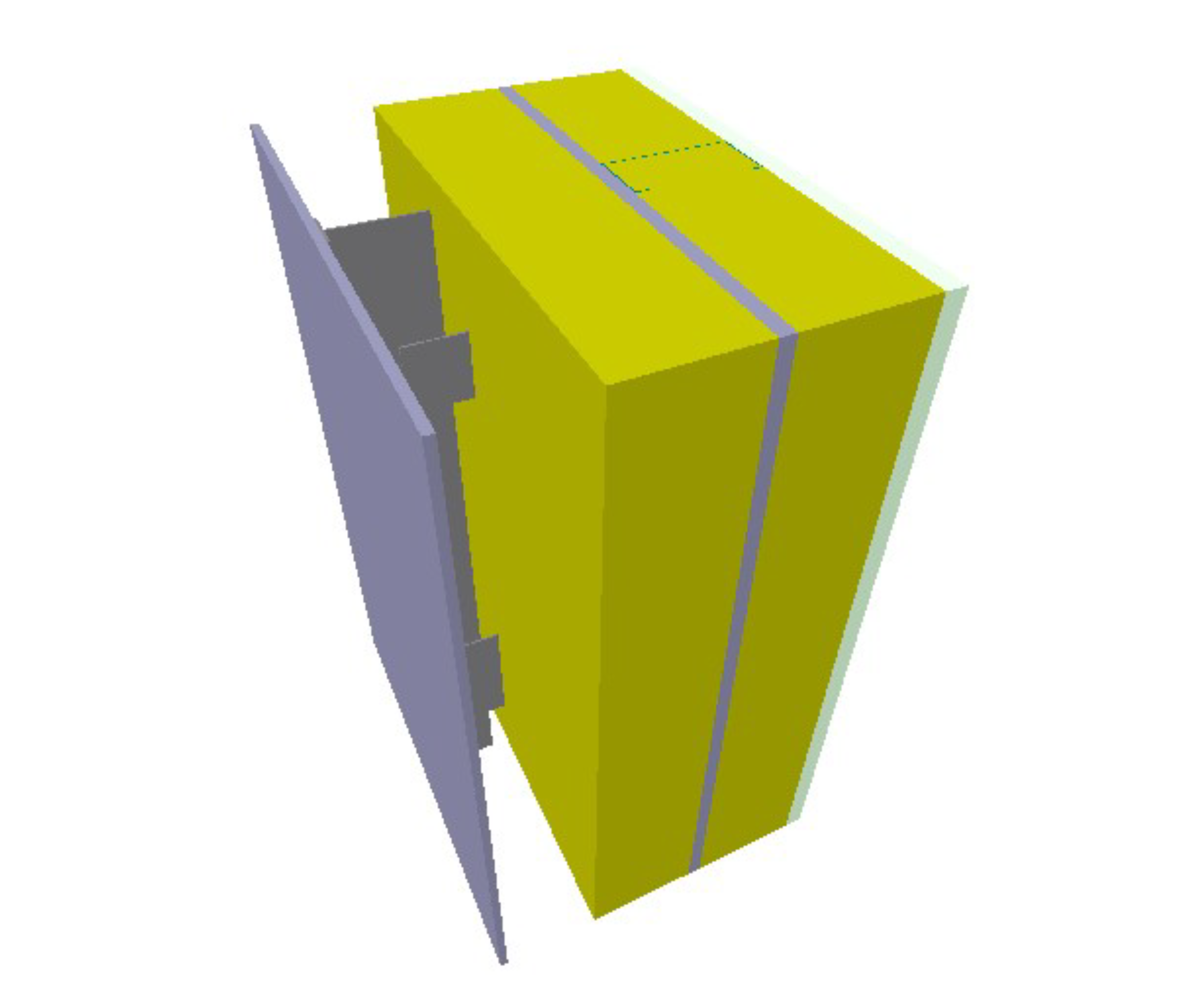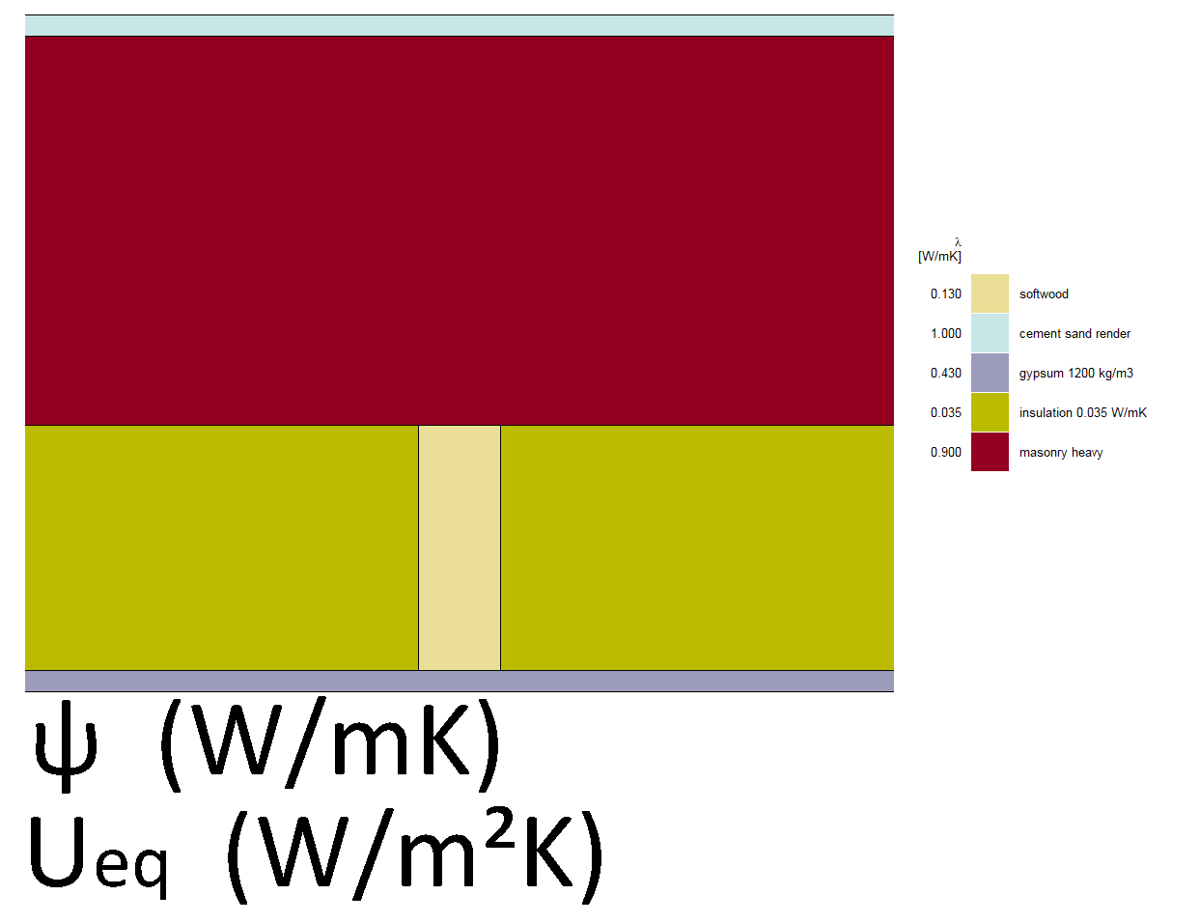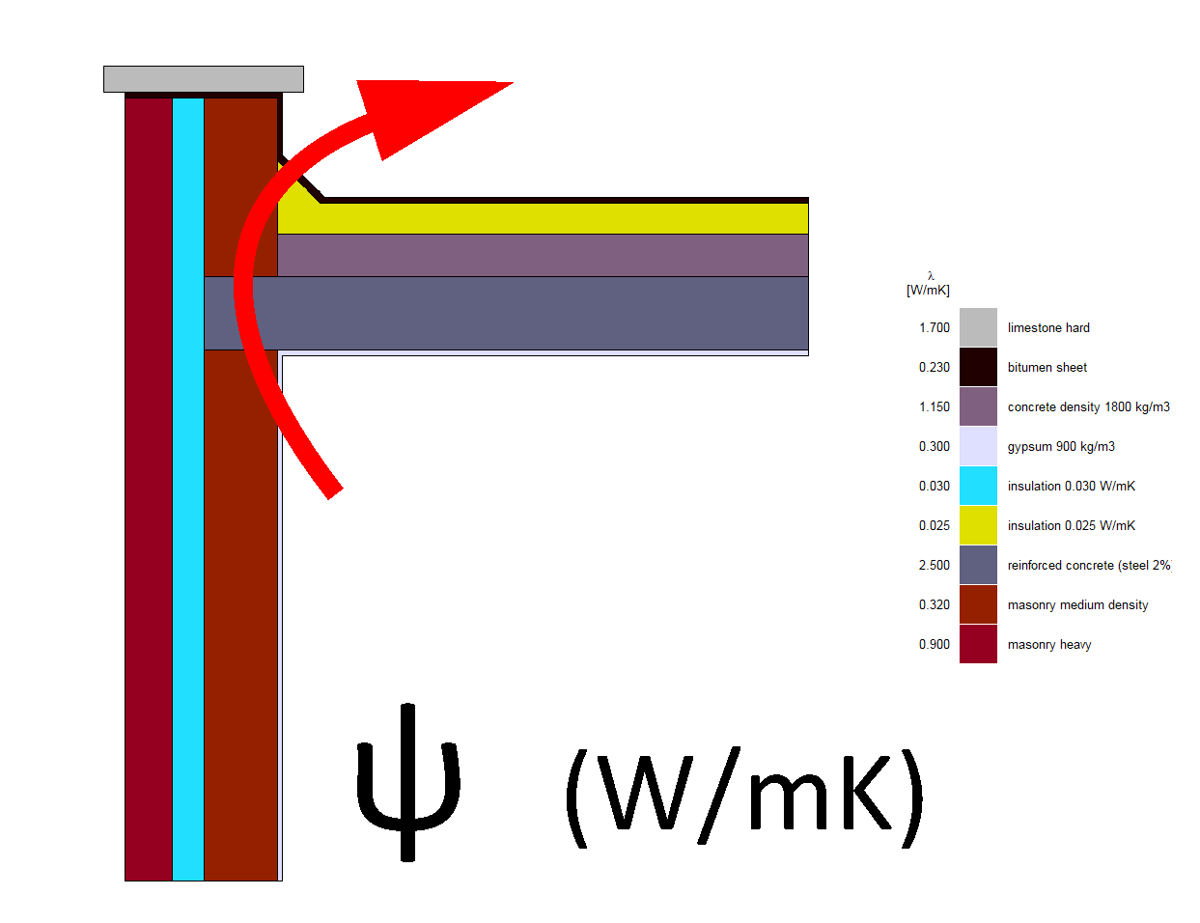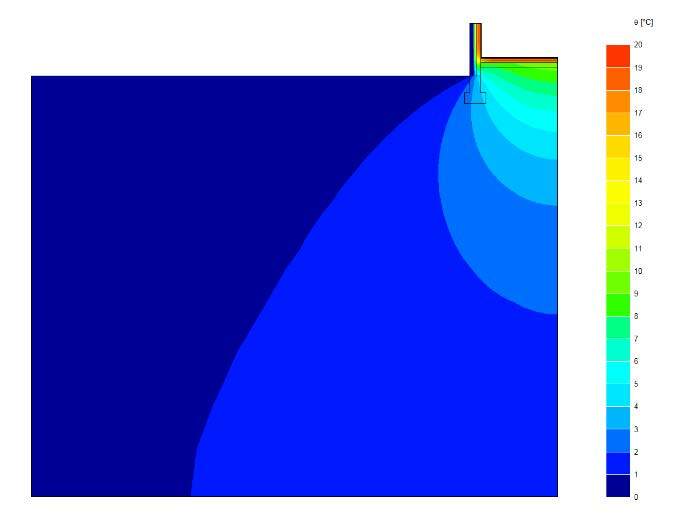Knowledge base
Use the following search fields to quickly find suitable documentation.
No search results found...

A14 - Validation of the program BISCO according to NFRC 100 and ISO 15099: comparison between BISCO and THERM
This document presents a comparison between simulation results from BISCO and THERM for window frame calculations based on NFRC-100 and ISO 15099 standards. In total six window frames are used in the analysis. The comparison includes both the Ufr and Ueg. The simulations in this document are executed using BISCO version 13.0.06 and THERM version 7.8.80.0. For the current set of window frames, the differences on the Ufr range from 0.3% to 0.7%, and for the Ueg from 0.1% to 1.4%.
download pdf download files
B22 - SAP junctions: a step-by-step guide using TRISCO software and BR497 v1
This document serves as a guide for thermal bridge modelers following national guidelines in the United Kingdom.
To support practitioners in UK, this document presents step-by-step examples of the most common junctions using the TRISCO software, adhering to BR497 principles. The reference naming for junctions from SAP (Table K1) is maintained (e.g. a steel lintel detail is referred to as an E1 junction).
Each example is accompanied by a DXF file, which can be directly loaded into TRISCO, as well as the final TRISCO files and calculation results. This allows the document to serve as a practical training resource for improving and evaluating TRISCO skills.
Keywords: SAP, BR 497, EN 10211, psi-value, UK
download pdf download files
B21 - Assigning distances and convective heat transfer coefficients for Ufr and Ueg calculations according to NFRC-100
This document clarifies how frame section models are set up for the calculation and reportings of the equivalent U-values according to NFRC-100. NFRC-100 specifies - based on ISO 15099 - how Ufr and Ueg should be reported. In document it is illustrated with 3 examples how the boundary conditions and distances should be set. The concept of 'sightline' plays herein a crucial role.
Keywords: NFRC, sightline, Ufr, Ueg, ISO 15099, frame, jamb, sill
download pdf download filesT-BSCe-Calculating the thermal transmittance of a window frame according to ANSI/NFRC 100
This tutorial explains step-by-step how to determine the thermal transmittance of a window profile (Uf-value) and edge of glass zone (Ueg) according to NFRC 100, which is based on the calculation procedure of ISO 15099.
Keywords: BISCO, NFRC 100, ISO 15099, frame, Uf, Ueg
download pdf download files
T-BSTb - BISTRA short tutorial series
Training videos for BISTRA covering most of the tools and settings within the software. This series of 6 videos is helpful for beginner to intermediate level users.
Access the Youtube channel here
- Introduction
- Basics and Interface
- Colours
- Getting started with dynamic simulations
- Functions
- Solar processor
- Glazed elements
- Ventilation
Keywords: BISTRA, Tutorials, Videos, Learning Material
download filesS5 - BISCO v13 release: overview of new features (7/02/2025)
In this webinar showcases the latest enhancements in BISCO v13.
✅ Automatic PDF report generation
✅ New standards (ISO 15099, EN ISO 673, NFRC 100/500)
✅ Batch calculations via UI & command line

F7-Condensation & Evaporation
A brief overview of the theory of condensation and evaporation in building constructions. The theory is accompanied with a spreadsheet for condensation and evaporation mass flow calculation.
Keywords: humid air, condensation, theory, mass flow, evaporation
download pdf download filesS3 - Condensation module in TRISCO (user event november 2024)
This seminar presents the Condensation module in TRISCO, a practical 3D heat and vapour model to estimate the risk for interstitial condensation in building enclosures. The module in fact a three-dimensional implementation of the Glaser method. The lecture, which was given on the 35 years Physibel event, covers the modelling assumptions and solution technique, validation against the literature and zooms on the applicability of the proposed model in comparison to more complex hygrothermal models. Finally, the results of an actual case are shown whereby the applicability of the model is demonstrated by making design decisions for the energetic retrofit of a curtain wall system.
The accompanying article was presented at the 13th Nordic Symposium on Building Physics (NSB 2023), Aalborg, Denmark on 12-14 June 2023
download pdfS4 - Tips and tricks - lecture (user event november 2024)

T-SLDd - SOLIDO short tutorial series
Training videos for SOLIDO covering most of the tools and settings within the software. This series of 9 videos is helpful for beginner to intermediate level users.
Access the Youtube channel here
- Introduction
- Basics and Interface
- Colours - part 1
- Colours - part 2
- Geometrical modelling
- Meshing part 1
- Importing STL files
- Meshing part 2
- Analysis
Keywords: SOLIDO, Tutorials, Videos, Learning Material
download files
T-BSCd - BISCO short tutorial series
Training videos for BISCO covering most of the tools and settings within the software. This series of 8 videos is helpful for beginner to intermediate level users.
Access the Youtube channel here
- Introduction
- Basics
- Importing Dxf to BISCO
- Colour Types Part-1
- Colour Types Part-2
- Uf value of frame (EN ISO 10077-2)
- Ψ-value of spacer bar (EN ISO 10077-2)
- Graphic and Text Output
- PDF report
- Batch Processing
Keywords: BISCO, Tutorials, Videos, Learning Material
download files
T-TRCd - TRISCO short tutorial series
Training videos for TRISCO covering most of the tools and settings within the software. This series of 10 videos is helpful for beginner to intermediate level users.
Access the Youtube channel here
- Introduction
- Basics
- Colours - part 1
- Colours - part 2
- Grids and Blocks
- Analysis Part 1 (Graphic output & Text output)
- Analysis Part-2 (Output U-values, linear and point thermal transmittance)
- Analysis part-3 (Linear thermal transmittance of corner joint)
- Importing DXF to TRISCO
- Advanced Modelling Tools
- Interstitial Condensation add-on
Keywords: TRISCO, Tutorials, Videos, Learning Material
download files
T-TR2Dd - Trisco2D short tutorial series
Training videos for Trisco2D covering most of the tools and settings within the software. This series of 3 videos is helpful for beginner to intermediate level users.
Access the Youtube channel here
Keywords: Trisco2D, Tutorials, Videos, Learning Material
download files
A11-Validation of the condensation feature (TRISCO) according to EN ISO 13788
Annex C of the standard EN ISO 13788 contains 6 examples of an interstitial condensation calculation and 1 example on drying of a wetted layer. These validation examples are calculated using the program TRISCO (condensation feature).
Keywords: TRISCO, Condensation feature, interstitial condensation
download pdf download files
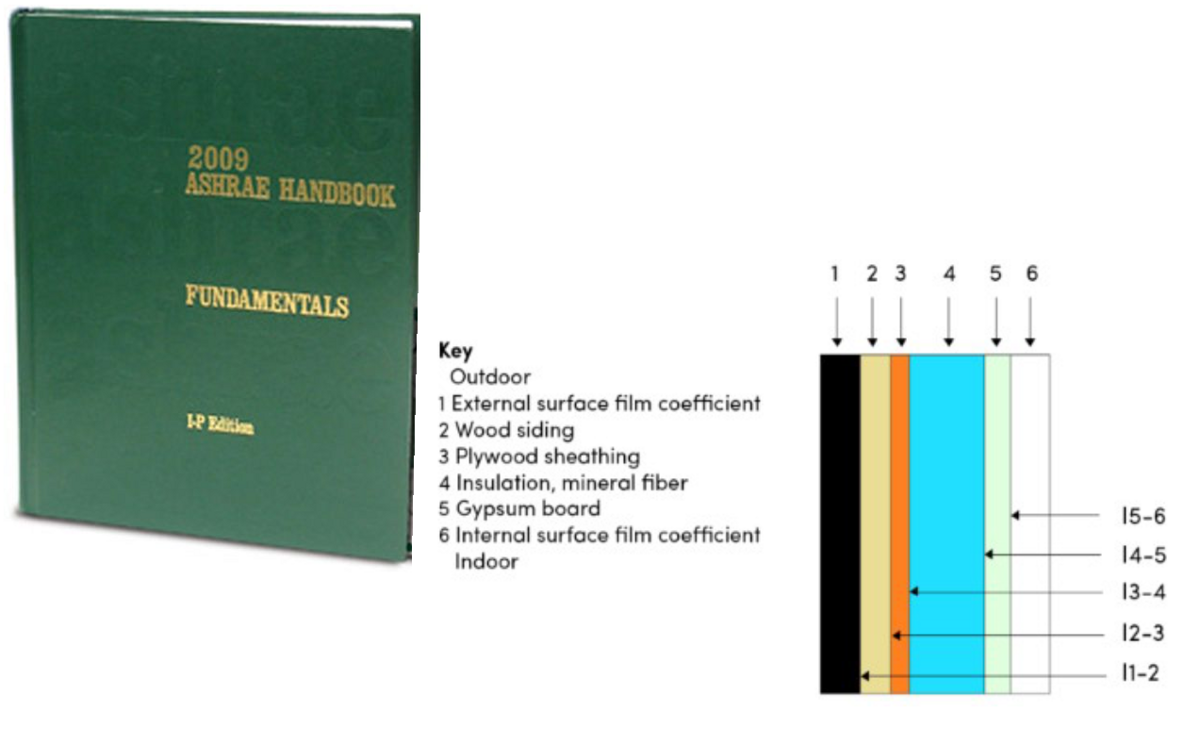
A15-Validation of the condensation feature (TRISCO) according to ASHRAE handbook
ASHRAE Handbook of Fundamentals contains 1 example of an interstitial condensation calculation and 1 example on drying of a wetted layer. These validation examples are calculated using the program TRISCO (condensation feature).
Keywords: TRISCO, Condensation feature, interstitial condensation
download pdf download files
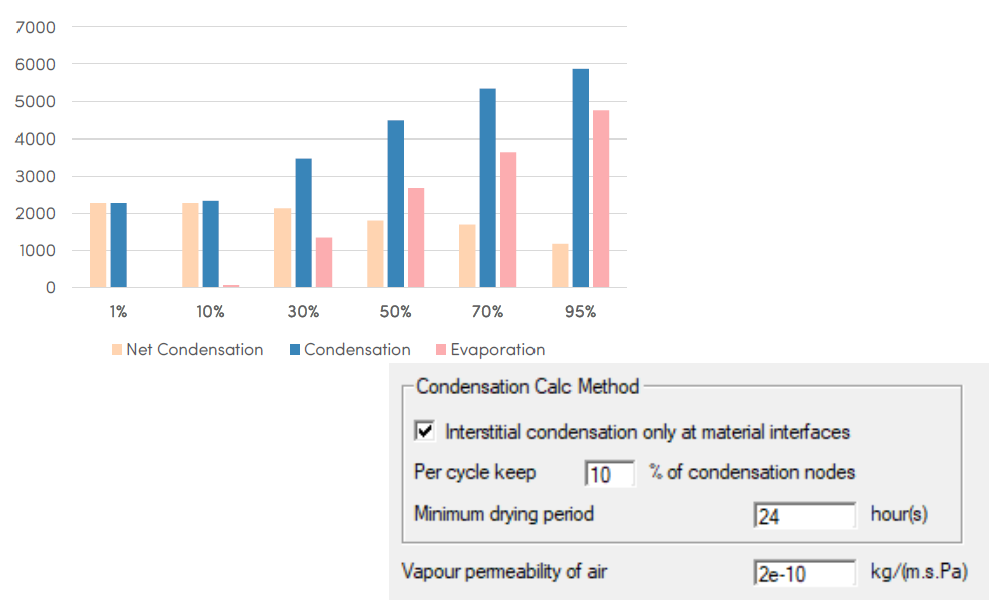
B20-Condensation module settings in TRISCO
The Condensation module in TRISCO introduces three calculation parameters. Understanding these parameters is essential for achieving accurate results while optimizing computation time.
Based on examples, the aim of the present document is to give the user general guidelines for these settings.
Keywords: Glaser method, interstitial condensation, condensation module
download pdf download files
F6-Unit conversion in condensation risk assessment
Vapour transport of building materials can be described by several quantities. Most common are: Vapour permeability (δ), Vapour permeance (P), Vapour resistivity (R) and Vapour diffusion resistance (Z). In addition, often derived quantities like the Vapour resistance factor (µ) and Equivalent air layer thickness (sd) are used in practice. The difference between imperial and metric unit system make it even more complex.
This document aims to clarify the definitions, standard units, and interrelations between these terms.
Keywords: Vapour diffusion, unit conversion
download pdf
T-SLDc - Defining air cavities in STL- imported geometries - Structural Glazing
Tutorial key elements:
- Modelling a 3D glazed façade via STL files
- Adding boundary conditions making use of superposition principle
- Defining air cavities in mullion and transom by splitting zone
Keywords: SOLIDO, STL, structural glazing, curtain wall, tutorial
download pdf download filesT-SLDb - Importing full model and boundary conditions via STL files - Rainscreen cladding
Tutorial key elements:
- Importing a rainscreen cladding wall via STL files
- Derived thermal properties: linear, point and equivalent thermal transmittance (ψ, χ, Uequi)
Keywords: SOLIDO, STL, bracket, rainscreen cladding, tutorial
download pdf download files
T-BSTa - Calculating the temperatures in window frame during a sunny day: getting started with BISTRA
Tutorial key elements:
- Climate data as boundary conditions
- Thermal properties
- Definition of solar data (position of thermal model in 3D coordinate system) and sun obstacles
- Graphic output and text output
Keywords: BISTRA, maximum temperature, thermal shock, thermal stress

G3-Validation of the program SOLIDO: heat transfer through sloped and curved surfaces
This document will discuss 2 validation examples with heat transfer through sloped and curved surface. The numerical results from SOLIDO will be compared with analytical results for conduction through 1) a plan wall and 2) composite walls (plane, cylindrical and spherical wall).
download pdf download filesS2 - Korean customer seminar (by EMPIAS) - 2023
Korean customer seminar organised by EMPIAS in March 2023. Based on examples, this seminar zooms in on some of the latest developments such as licence system (floating licences), improved workflow in SOLIDO, condensation feature in TRISCO v16 and specular reflection in BISTRA v5.

F1-Humid air: theory and Physibel online tool
A brief overview of the theory of humid air is given in order to better understand the phenomenon of condensation in building constructions. The theory is accompanied with Physibel online tool for psychometrics calculation.
Keywords: humid air, condensation, theory, dew point, online tool, psychometric
download pdf download files
F2- Preparing indoor and outdoor climate data for use in the physibel program GLASTA according to EN ISO 13788
To evaluate the interstitial condensation risk in plane constructions, indoor and outdoor temperature and relative humidity or vapour pressure need to be known. Typically monthly mean values are used. Monthly mean values for the outdoor climate easily can be found in databases. During the design stage the use of indoor climate classes as defined in EN ISO 13788:2012 is recommended. A procedure to prepare these climate data is given.
Keywords: climate class, GLASTA, humid air, condensation, EN13788, spreadsheet
download pdf download files
M1 - Trisco2D manual
This manual is intended as a complete reference for the Trisco2D application.
download pdf
M2 - TRISCO manual
This manual is intended as a complete reference for the TRISCO application.
download pdf
M3 - SOLIDO manual
This manual is intended as a complete reference for the SOLIDO application.
download pdf
M4 - BISCO manual
This manual is intended as a complete reference for the BISCO application.
download pdf
M5 - BISTRA manual
This manual is intended as a complete reference for the BISTRA application.
download pdf
M6 - VOLTRA manual
This manual is intended as a complete reference for the VOLTRA application.
download pdf
M7 - GLASTA manual
This manual is intended as a complete reference for the GLASTA application.
download pdf
C9-Simulating 2D interstitial condensation using the program BISCO and TRISCO/SOLIDO
BISCO is designed for simulating two-dimensional steady state heat transfer. However, as the governing mathematical equations for vapour diffusion are similar to the ones for heat transfer, the program can be used for simulating vapour diffusion as well. The document explains how to use BISCO to predict interstitial condensation in a construction detail. The same principles can be applied to calculate interstitial condensation in 3D with the programs TRISCO or SOLIDO.
Keywords: BISCO, TRISCO, SOLIDO, condensation, vapour diffusion, vapour pressure, relative humidity
download pdf download filesS1 - Seminar 24/11/2022: Thermal modelling of building envelope systems in a European context
This seminar, organised together with TU Dublin, focusses on the European standards dealing with thermal modelling of building elements.
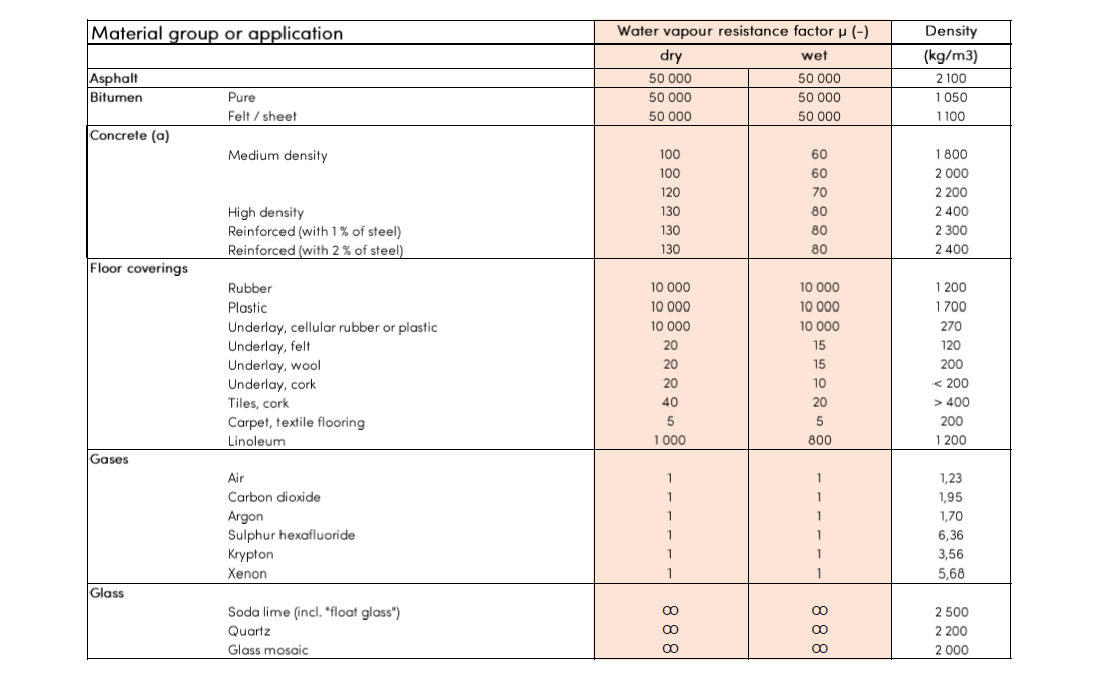
A13 - Material properties: standardised values for water vapour resistance factor
This documents lists standardised water vapour transport properties from EN 12524:
- Table 1: General building materials
- Table 2: Thermal insulation materials and masonry materials
- Table 3: Foils
T-BSCa-Thermal transmittance of a window profile according to EN ISO 10077-2
This tutorial explains step-by-step how to determine the thermal transmittance (Uf-value) of a window profile.
Keywords: BISCO, EN 10077-2, frame, Uf
download pdf download filesT-BSCb- Linear thermal transmittance of a glazing spacer according to EN ISO 10077-2
This tutorial explains step-by-step how to determine the linear thermal transmittance of a glazing spacer
Keywords: BISCO, EN 10077-2, spacer, psi-value
download pdf download files
A5-Validation of the programs CAPSOL, BISTRA and VOLTRA according to EN ISO 13786
In EN ISO 13786 , a method is given to calculate dynamic thermal characteristics of 1D building components. These characteristics can be derived using the transient Physibel programs CAPSOL (version 4.0w), BISTRA and VOLTRA. For the 2 example components given in annex D of the standard, the characteristics are derived using these programs.
Keywords: CAPSOL, VOLTRA, BISTRA, dynamic thermal characteristics
download pdf download files
A10-Validation of the program GLASTA according to EN ISO 13788
Annex C of the standard EN ISO 13788 contains 6 examples of an interstitial condensation calculation and 1 example on drying of a wetted layer.
Keywords: GLASTA, interstitial condensation, drying out

A12-Material and boundary conditions: EN ISO 10077-2, EN ISO 6946, EN ISO 10456, ISO 15099 and NFRC (Colour Database)
This document lists the default Colour database which is based on a selection of materials and boundary conditions from EN ISO 10077-2, EN 6946 EN ISO 10456, ISO 15099 and NFRC
Keywords: Colour Database, material properties, boundary conditions
download pdf download files
B8-Glazed facades: derived thermal properties
From 2D thermal simulations of glazed façade parts several derived thermal properties can be defined. There purpose is to allow corrections on 1D formulas when doing a whole building thermal analysis. Typical derived properties and there interrelation are discussed.
Keywords: BISCO, TRISCO, UTJ, Uf, psi
download pdf download files
B10-Thermal transmittance of a window according to EN ISO 10077-1
The calculation of the thermal transmittance of a window according to EN ISO 10077 is applied for a window containing 2 different frame sections simulated using the program BISCO.
Keywords: BISCO, Uw, Uf
download pdf download files
B11-Solar factor of a window
The solar factor of a window can be calculated from the solar factor of the opaque frame and the solar factor of the glazing. In a first section the solar factor of an opaque element is discussed. In a second section the solar factor of the glazing is discussed. Then both solar factors are used to derive the window solar factor.
Keywords: BISCO, g-value, g-factor, EN 410
download pdf download files
G2-2D THERMAL SIMULATION OF ANGLED AND CURVED SHAPES vs. RECTANGULAR SHAPES: BISCO vs. TRISCO
The program TRISCO is initially made to simulate block shaped 2D/3D objects. The program uses a rectangular calculation grid. The program BISCO is limited to 2D but allows objects with any shape. The program uses a triangular calculation grid. This document compares both approaches and sets their applicability.
Keywords: TRISCO, BISCO, triangular vs. rectangular grid
download pdf download filesT-BSCc- Linear thermal transmittance of a roof junction according to EN ISO 10211
This tutorial explains step-by-step how to determine the linear thermal transmittance of line thermal bridge by the example of a roof junction.
Keywords: BISCO, EN 10211, roof junction, psi-value
download pdf download files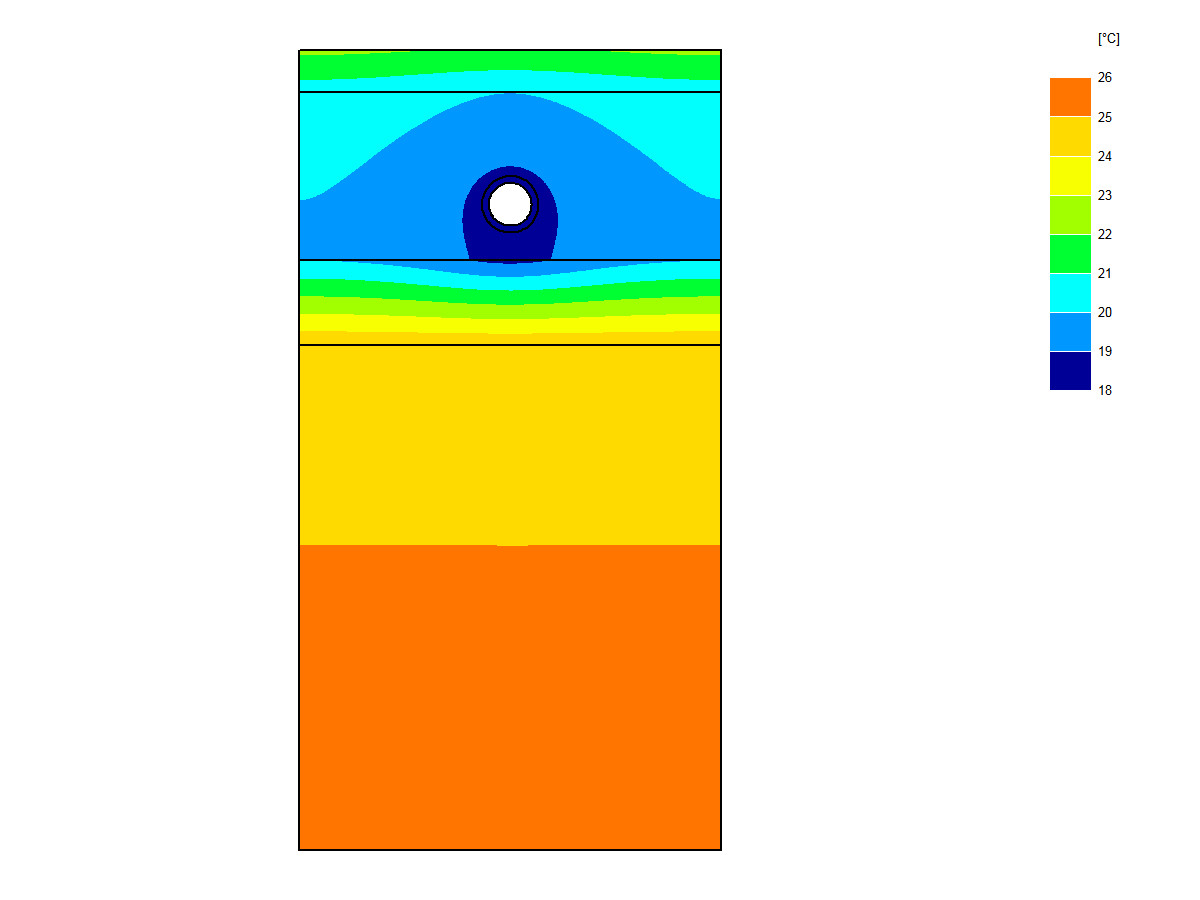
A4-Bisco validation EN ISO 11855-2 floor heating
EN 15377 Annex D of the standard EN ISO 11855-2:2015 contains a test example that must be used to verify a steady state numerical calculation program. The program BISCO is used to simulate the test example.
keywords: BISCO, EN ISO 11855-2, floor heating, validation, standard
download pdf download files
B12-Air cavities within EN ISO 10077-2: comparison between radiosity method and single equivalent thermal conductivity method
In construction elements such as window frames and bricks, the heat transfer through air cavities is often an important part of the global heat transfer through them. The heat transfer mechanisms are infrared radiation and conduction (in case of still air) or convection (in the case of flowing air).
Keywords: BISCO, RADCON, EN 10077-2, window frame, cavity heat transfer
download pdf download files
F4-Calculation of convective heat transfer coefficients
The convective heat transfer coefficient can be derived from empirical relations as described in multiple textbooks on heat transfer. Some of these relations were implemented in spreadsheet files allowing the calculation of the convective heat transfer coefficient for typical situations.
Keywords: convective surface coefficient, excel tools
download pdf download files
F3-Preparing climatologic data in physibel software format
This document explains how climatic data (Meteonorm, TRY, TMY2s, measured data, standard data) can be converted into the Physibel software format using a spreadsheet file. A procedure is given to control the solar data.
Keywords: climate data, VOLTRA, BISTRA, CAPSOL
download pdf download files
D2-U-value estimations based on measured temperatures - internal surface heat transfer
The theory of 1D steady state heat transfer learns that the thermal transmittance U of a wall with parallel layers easily can be derived from the environmental temperatures θi and θe, the internal surface temperature θis and the internal surface heat transfer coefficient hi.
This would in theory allow to estimate the U-value of 1D-building components based on IR-thermography measurements.
In a case study a temperature distribution in steady state conditions for a well-defined building zone is generated numerically. The detailed numerical heat transfer simulation, based on 3D conduction, view factor based radiation (radiosity method) and empirical convection, guarantees a quite realistic temperature distribution.
The model is used to assess the uncertainties on U-value estimations based on IR-thermography measurements.
Keywords: U-value estimation, IR thermography
download pdf download files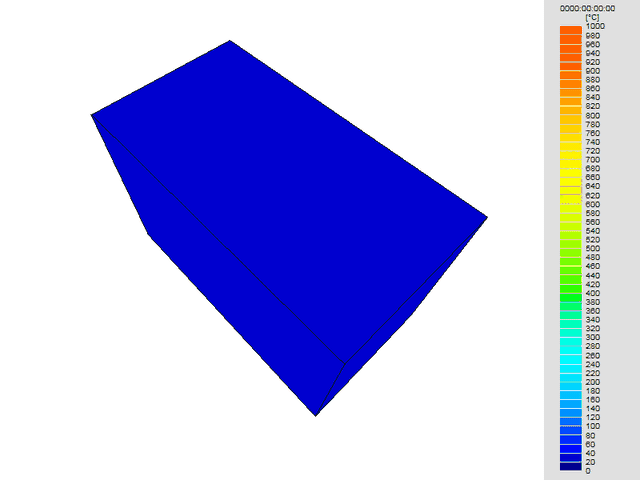
A6-Simulation of fire exposed structures. Validation of the programs BISTRA & VOLTRA according to the EUROCODES (EN 1992-1-2:2004)
EN 1992-1-2: 2004 Annex A contains a 2D test reference case for validating transient simulation programs in case of fire exposed structures. A concrete column (h x b = 300 mm x 160 mm) is exposed to fire conditions. The case is simulated using the programs BISTRA and VOLTRA.
Keywords: BISTRA, VOLTRA, EN 1992-1-2:2004, fire, dynamic, concrete
download pdf download files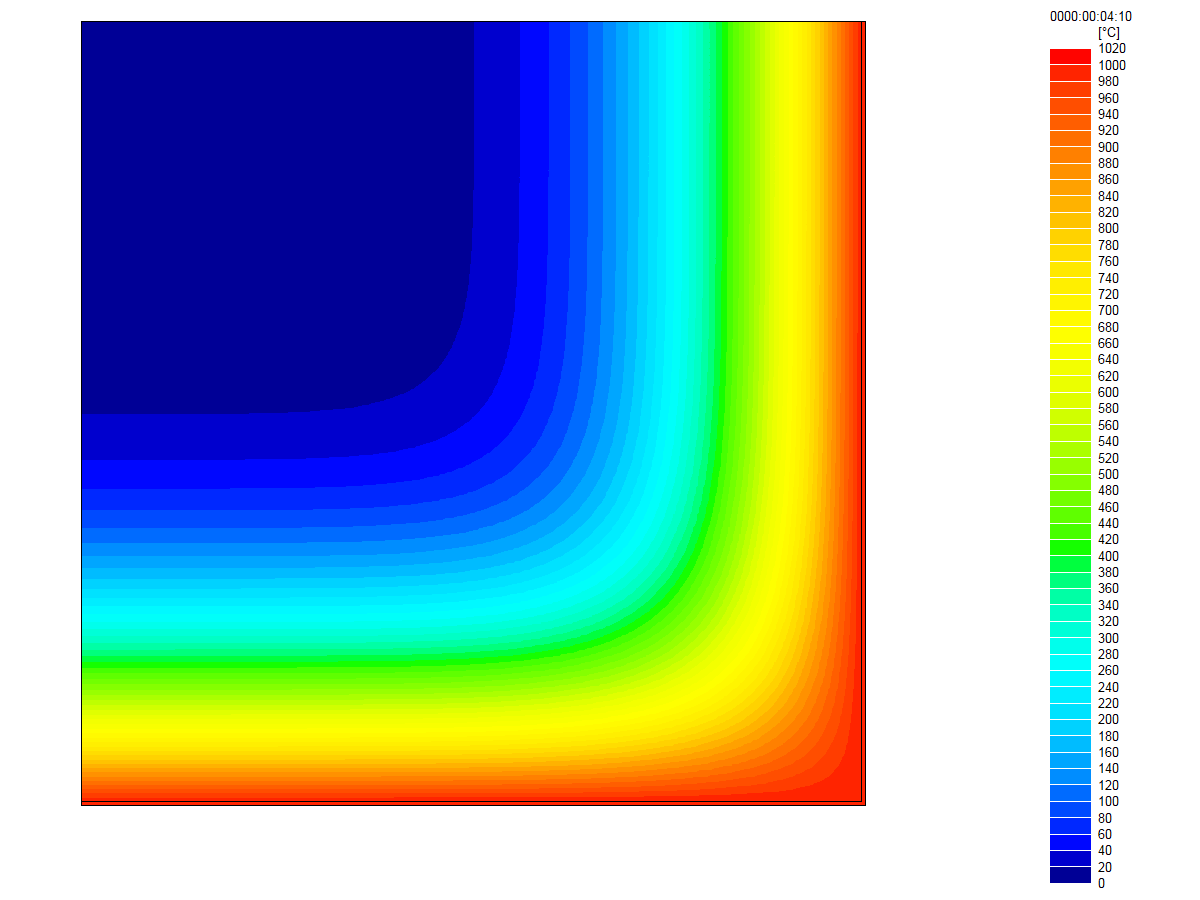
A7-Validation of the programs BISTRA and VOLTRA according to DIN EN 1991-1-2NA:2015-09
The document DIN EN 1991-1-2/NA (2015-09) annex CC contains test reference cases for validating transient simulation programs in case of fire exposed structures. The cases are simulated using the programs BISTRA and VOLTRA and the results are within the requested tolerances for each case.

A8-Validation of the programs BISTRA and VOLTRA according to SP REPORT 1999:36
This document discusses the BISTRA and VOLTRA simulation results for 8 the reference cases described in SP REPORT 1999:36

T-TRCa - Geometrical modelling functions: getting started with TRISCO
This first tutorial deals with the object modelling functions in TRISCO. The overall modelling philosophy via a coordinate system and blocks will be illustrated for a simple room corner. Thereafter, the obtained model will be used to show how to quickly combine and adjust existing models via block transformations.
Tutorial key elements:
- Creating a geometrical model from scratch
- Coordinate system and blocks
- Block transformation functions
Keywords: TRISCO, wall-to-roof, exercise

T-TRCb - Geometrical input of a DXF file via TriscoDXF (prepared DXF file)
Tutorial key elements:
- Creating a geometrical model starting from a DXF file
- Using TriscoDxf to convert a DXF file to a BMP file, for input in TRISCO
- Derived thermal properties: linear thermal transmittance (ψ)
- Generating a calculation report
- Revolve function to get a 3D object from a 2D geometry
Keywords: TRISCO, wall-to-roof, exercise, DXF, TriscoDXF
download pdf download files
T-TRCc - Geometrical input by using a DXF-underlayer (unprepared DXF file)
Tutorial key elements:
- Creating a geometrical model with the help of a DXF-underlayer
- Automatic grid line detection in Trisco2D
- Interactive material and boundary condition selection
- Loading Trisco2D models in TRISCO
- Revolve function to get a 3D object from a 2D geometry
- Changing thermal palette
Keywords: TRISCO, wall-to-roof, exercise, DXF, Trisco2D
download pdf download files
T-SLDa - Geometrical modelling functions: getting started with SOLIDO – mushroom column
This first tutorial deals with the object modelling functions in SOLIDO. The overall modelling philosophy of solids, defined via a coordinate system (block points) will be illustrated for a simple mushroom column.
Tutorial key elements:
- Creating solids in SOLIDO
- Coordinate system and block points
- Equivalent and point thermal transmittance (Uequi and χ)
Keywords: SOLIDO, solids, mushroom column
download pdf download filesT-TR2Da- Equivalent thermal transmittance (U2D) and linear thermal transmittance (Ψ) of a repeating thermal bridge
This tutorial shows how to calculate the U2D-value and ψ-value for a repeating thermal bridge.
Tutorial key elements:
- Creating a geometrical model from scratch
- Derived thermal properties: U2D-value and ψ-value
Keywords: TRISCO, Trisco2D, EN 10211, interior insulation
download pdf download filesT-TR2Db- Linear thermal transmittance of a roof junction according to EN ISO 10211
This tutorial explains how to model the linear thermal transmittance of a roof junction.
Tutorial key elements:
- Creating a geometrical model starting from a .dxf file
- Drawing sloped elements
- Derived thermal properties: linear thermal transmittance (Ψ)
Keywords: TRISCO, Trisco2D, EN 10211, roof junction
download pdf download filesT-TR2Dc- Equivalent thermal transmittance of a slab-on-ground floor (U’g)
This tutorial explains how to calculate the ground heat losses of a slab-on-ground floor.
Tutorial key elements:
- Creating a geometrical model starting from scratch
- Interpretation of numerical output
- Derived thermal properties: equivalent thermal transmittance of a floor on the ground
Keywords: TRISCO, Trisco2D, EN 10211, floor, foundation
download pdf download files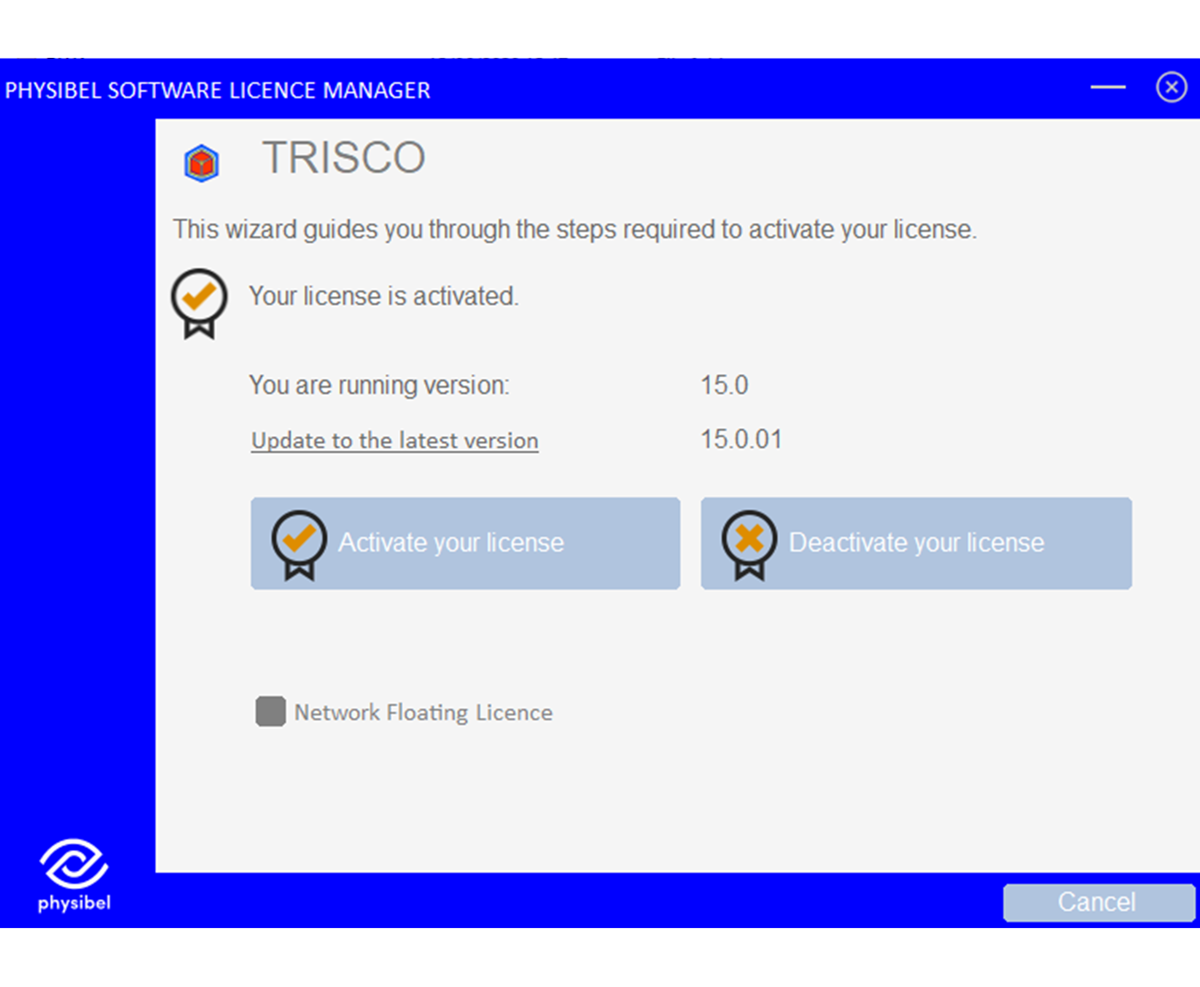
J5 - How to transfer a stand-alone software licence to a different computer
The stand-alone software licence key is linked to a computer. This document explains how to transfer the licence to another computer.(note: maximum 5 licence transfers per year)
Keywords: software licence, stand-alone, transfer licence
download pdf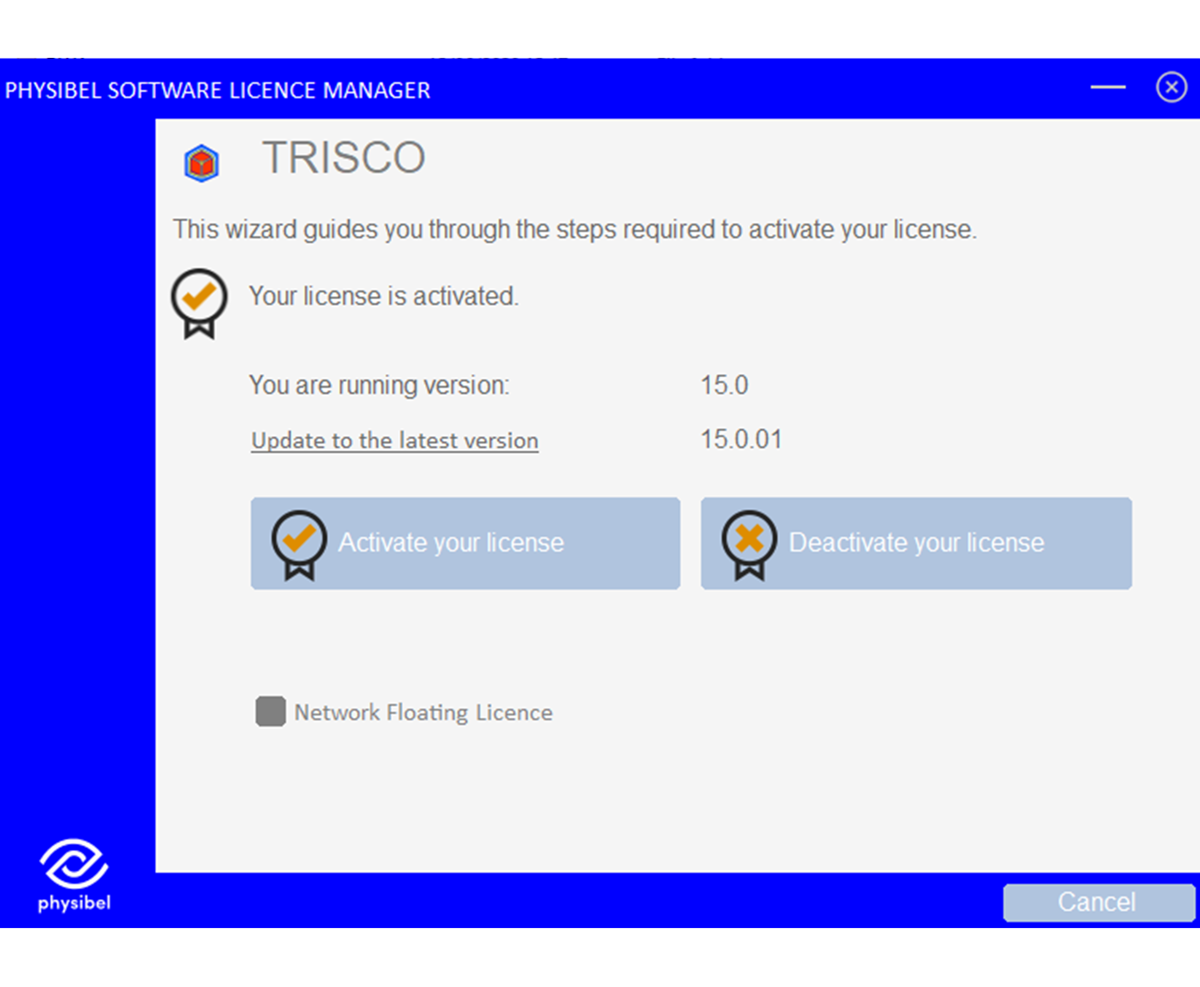
J4 - How to activate a stand-alone software licence
The Physibel applications are protected by either a hardware licence (Sentinel USB key) or a software licence.
This document explains how to activate a stand-alone software licence.
Keywords: software licence, stand-alone, setting up
download pdf
J1-Licence specifications: overview
Overview of the specifications of the different Physibel licence options.
Keywords: licence
download pdf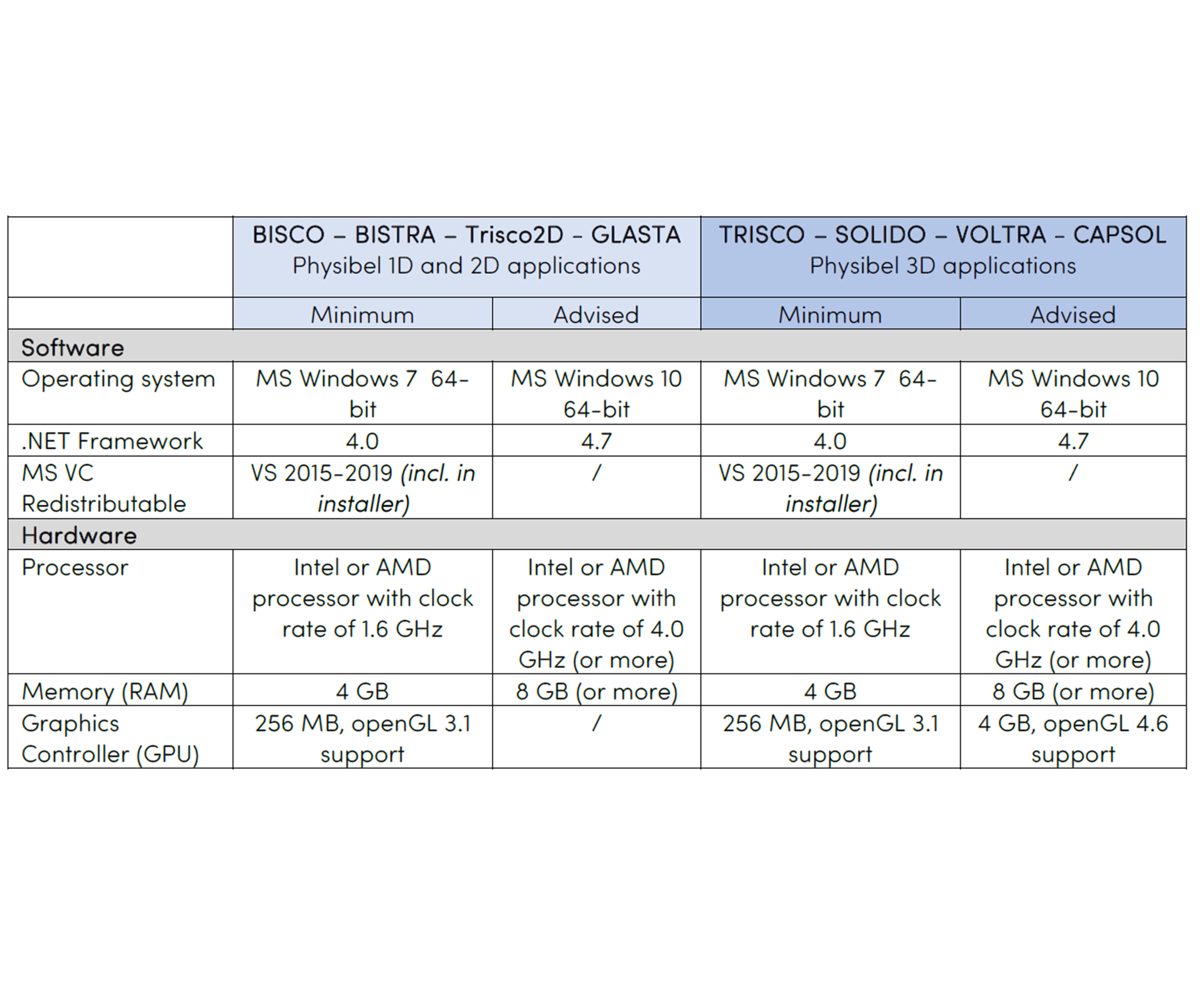
J2- Technical requirements for Physibel applications
Technical requirements for work stations to run Physibel applications
Keywords: requirements, hardware, GPU
download pdf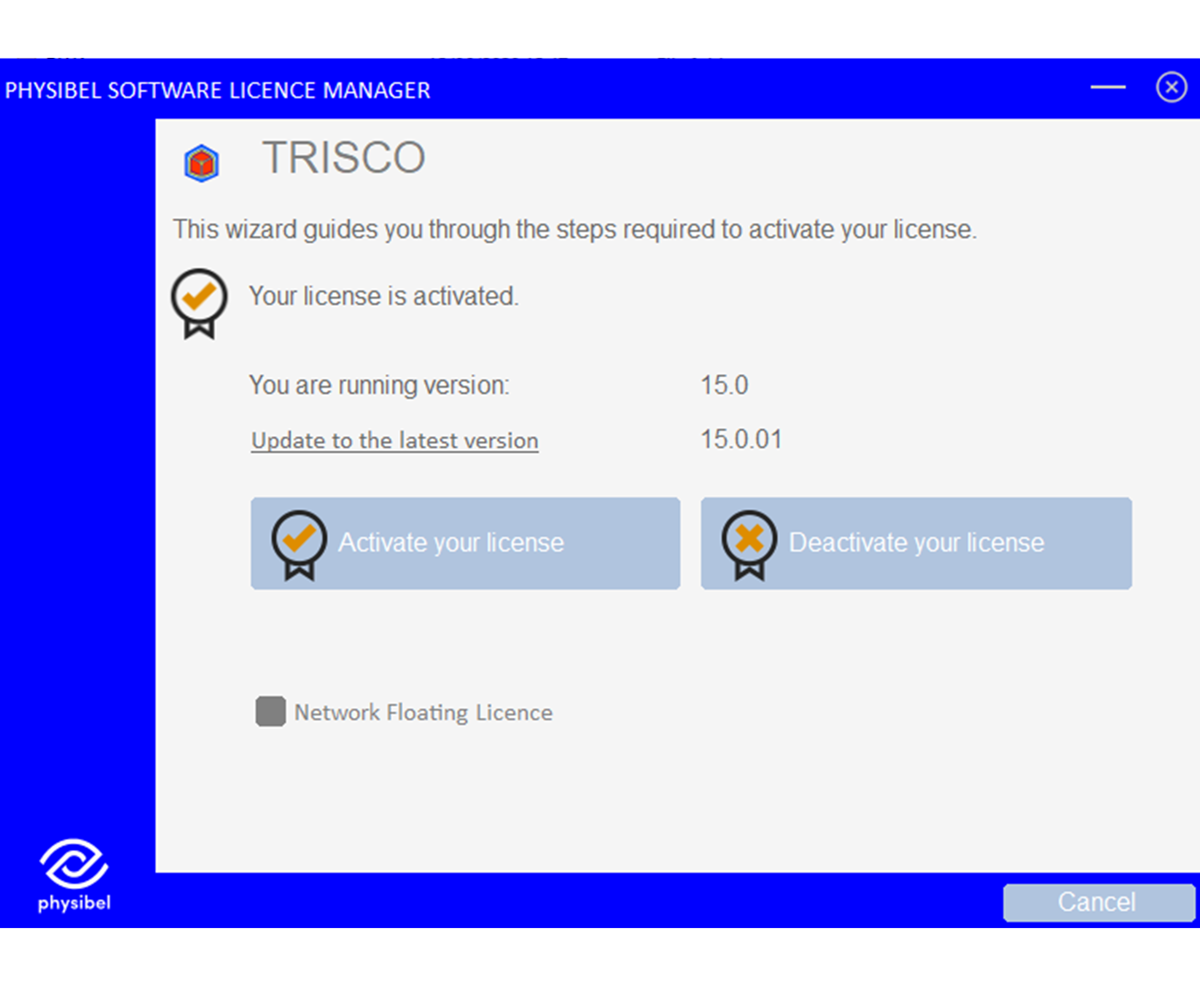
J3 - How to update to a newer version
This document explains how to update the software to the latest version for a
a) software key licence and b) hardware key licence.
Keywords: software update, installation files, upgrade
download pdf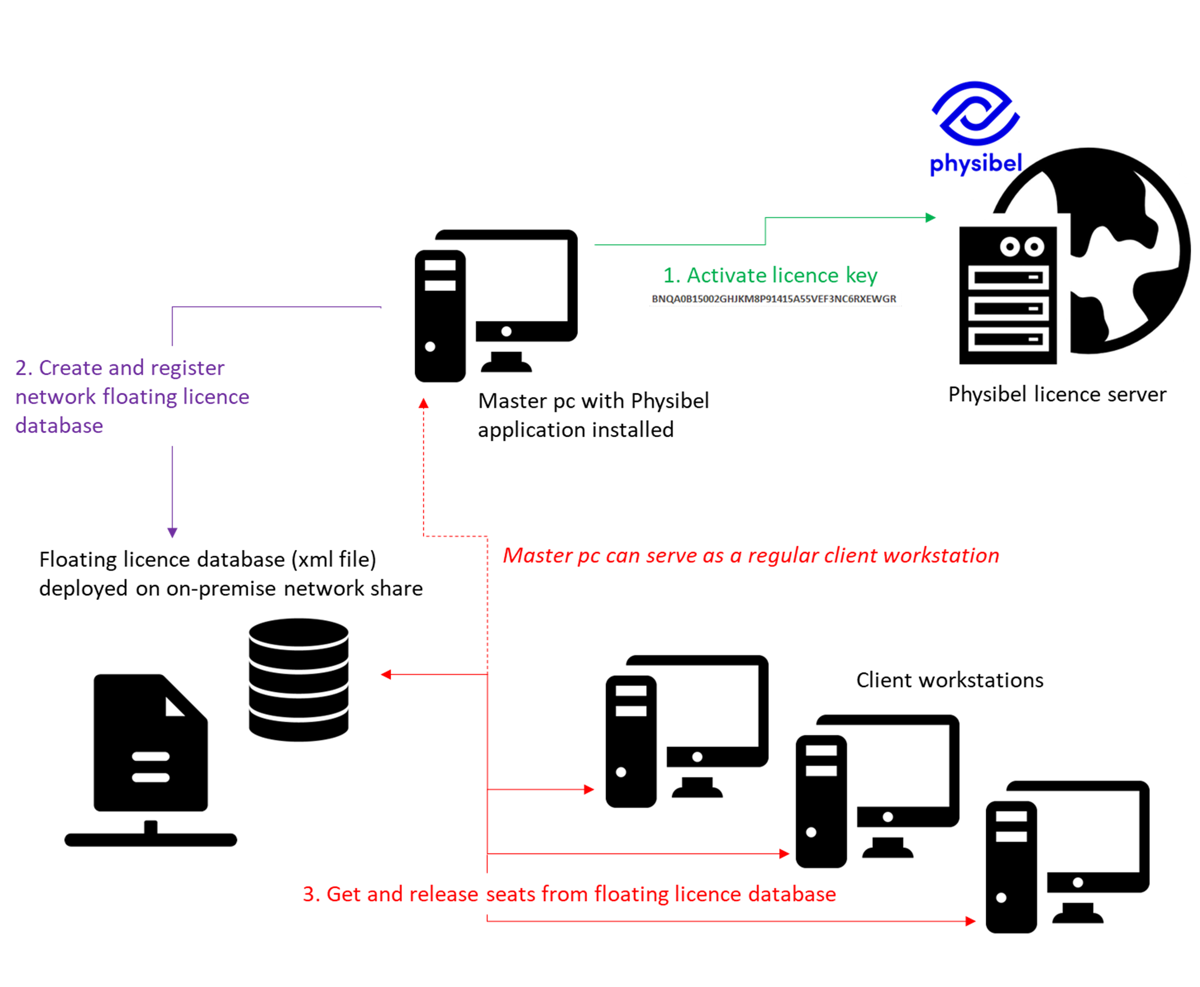
J6 - How to set up and manage a network floating licence database: information for admins
This document explains how to set up and manage a network floating licence database for concurrent use of Physibel applications.
This document is aimed at administrators of the database, not the users of it.
Keywords: software licence, network floating, admin info
download pdf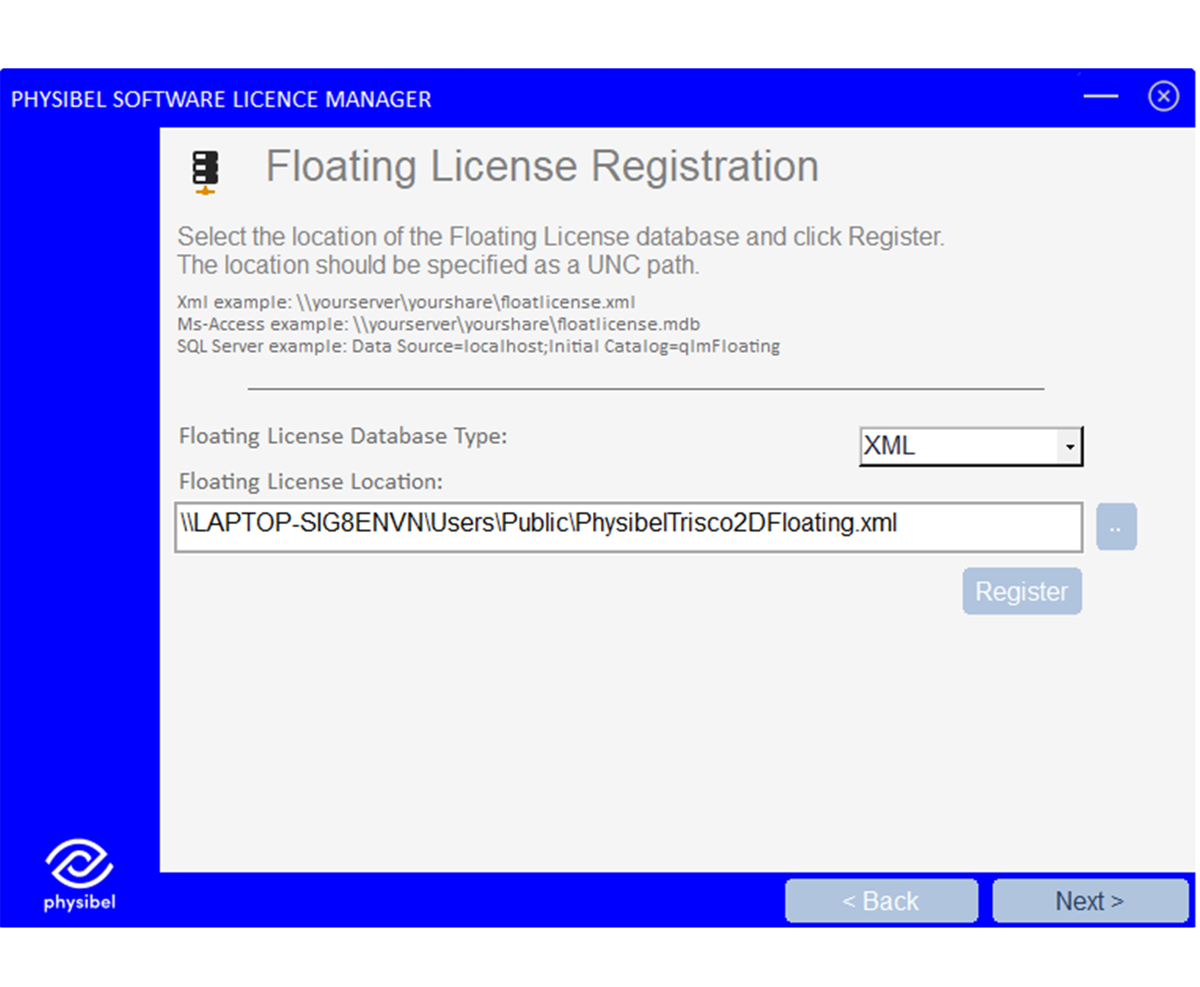
J7 - How to use a seat from a network floating licence database: information for users
This document explains how to use a seat from a configured network floating licence database
for concurrent use of Physibel applications.
Keywords: software licence, network floating, user info
download pdf
J8 - How to use a cloud-based floating software licence
A cloud-based floating licence is operational with a licence server hosted by Physibel in the cloud
from which users (automatically) request a seat when opening the Physibel application.
This document explains how to activate a cloud-based floating software licence.
Keywords: cloud-based floating, subscription licence
download pdf
F5-Exporting node temperatures in the programs BISCO & BISTRA (.sol -file)
This document explains how to handle node temperatures from the solution file with extension .sol for the programs BISTRA & BISCO for external post-processing purposes.
Keywords: BISCO, BISTRA, .sol-file, node temperatures
download pdf download files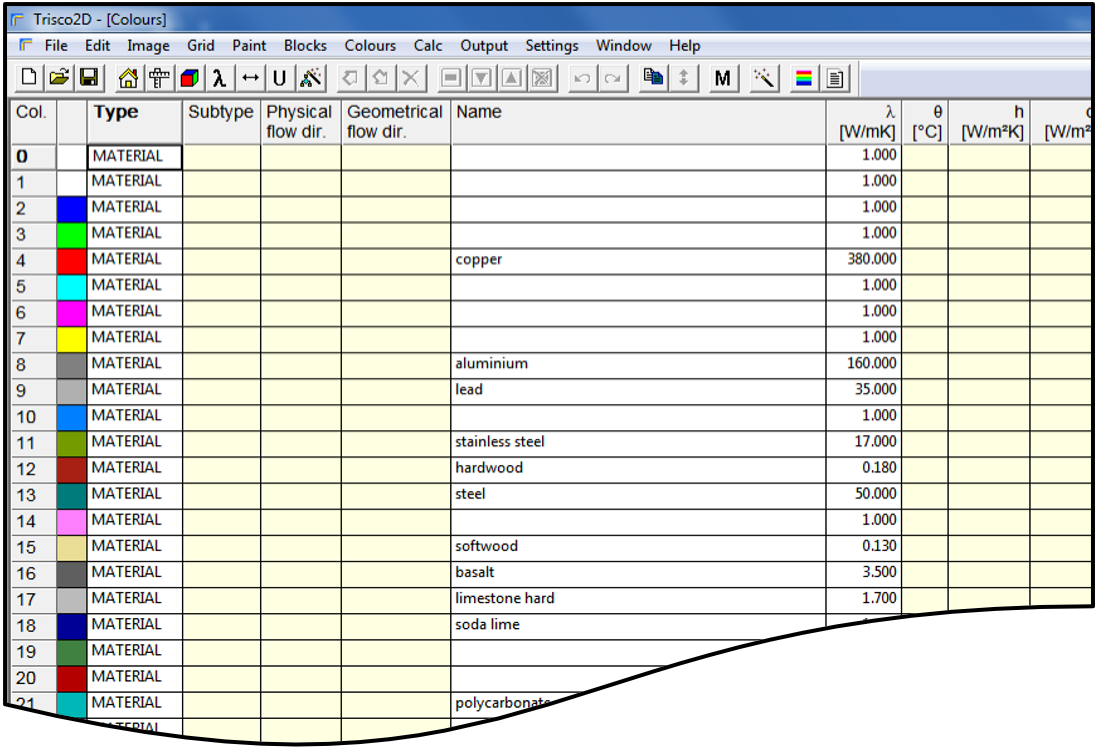
H1 - What is the difference between the colour database and the material database(s)?
Keywords: Colour database, Material database, material properties
download pdf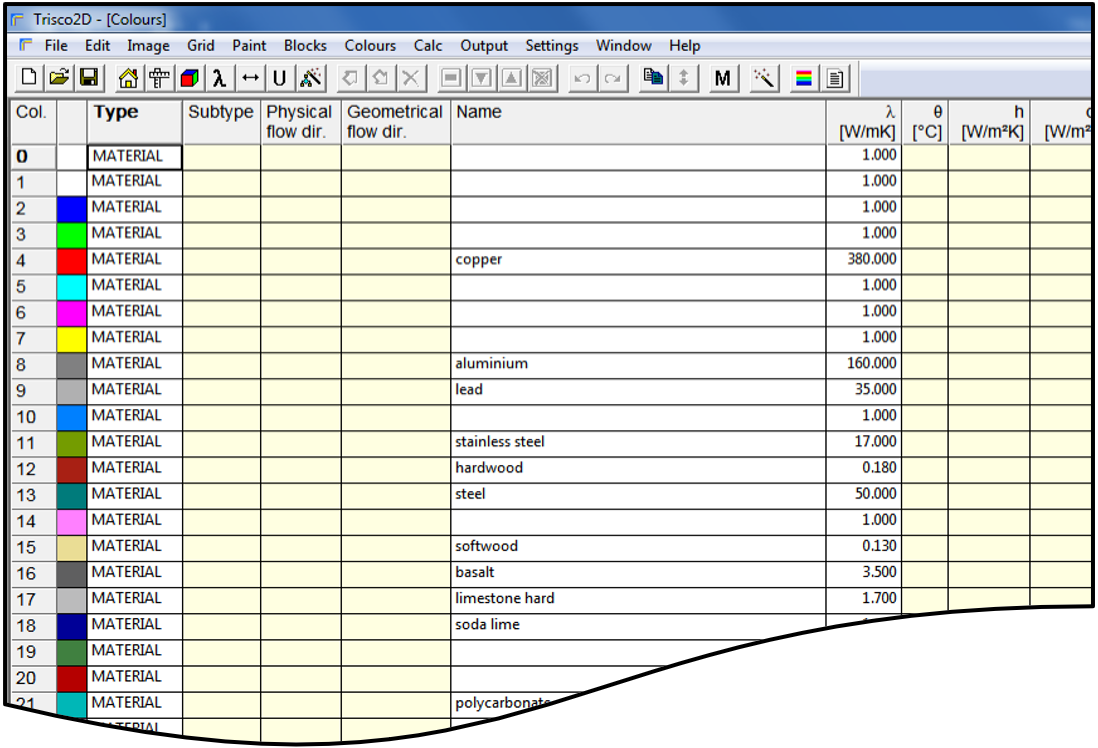
H2 - How to modify the colour database?
Keywords: Colour database, Material database, material properties
download pdf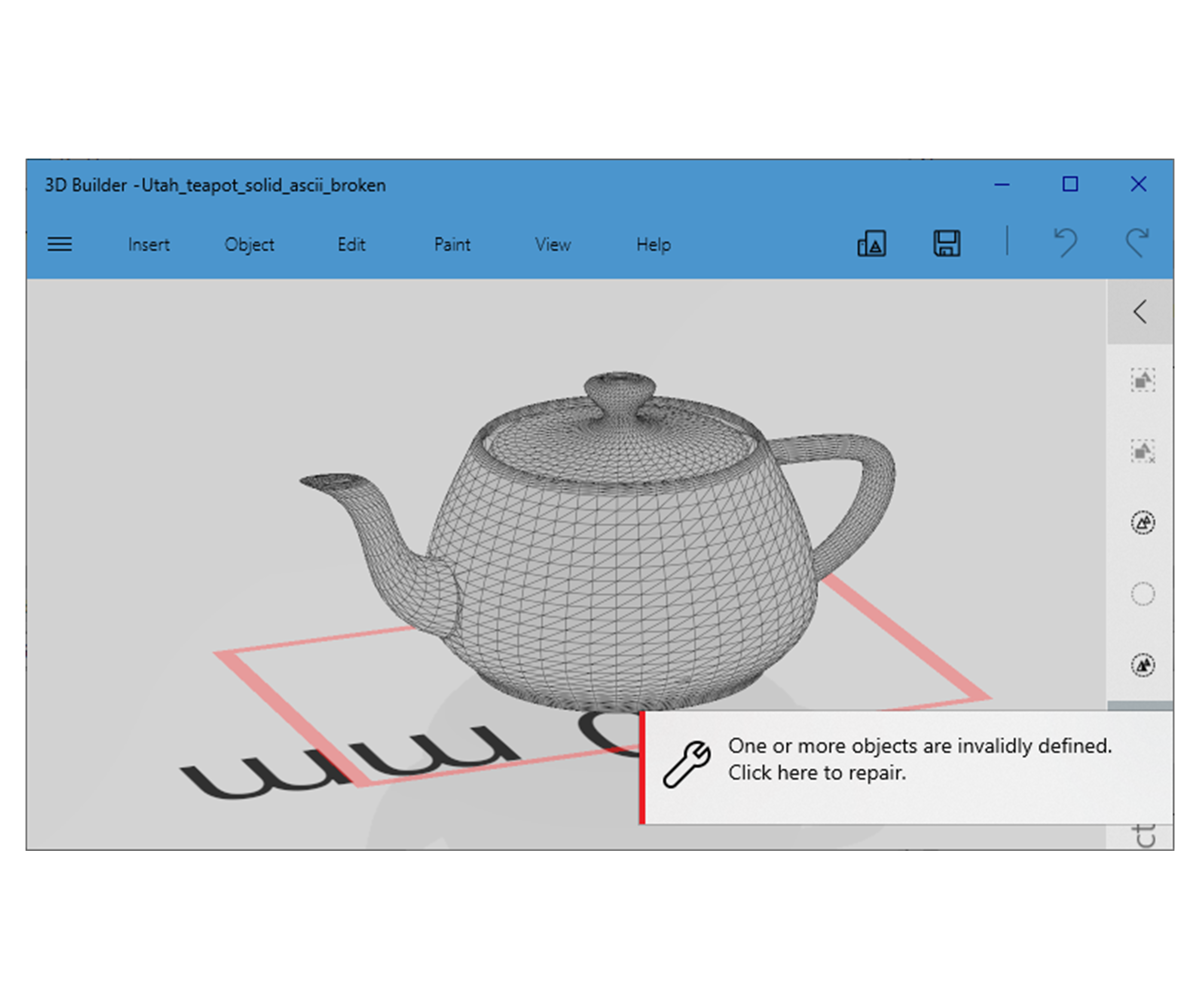
H6 - How to fix a broken STL file for SOLIDO ?
For optimal use in SOLIDO the triangles defining the object in the STL-file should create a “watertight” surface.
When the STL file is missing triangles in its surface, problems may occur when using the files as input in SOLIDO.
This problem is illustrated with the ‘Utah teapot STL’ file in which on purpose 1 triangle is removed
(by opening the ASCII version of this STL file with a text editor).
Keywords: STL, SOLIDO, broken STL
download pdf download files
H3 - How to assign colour properties to DXF-layers?
This document explains how to link colour information to the DXF-layer in order to speed up the geometrical input via:
- Method 1: A layer definition file (.lay)
- Method 2: Adding a prefix (“xxx_y_name”) to the DXF layer name
Keywords: DXF, layer, database, BISCO, TRISCO, .lay-file
download pdf
H4 - How to manage the default layer definition file (BiscoDxf.lay or TriscoDxf.lay)?
This Physibel How To explains how to set up and maintain the BiscoDxf.lay/TriscoDxf.lay file.
The default layer definition file (BiscoDxf.lay for BiscoDxf and TriscoDxf.lay for TriscoDxf, respectively)
is a database which allows to link frequently used DXF layer names to Physibel colour information (Colour database).
The use of a default layer definition file speeds up the geometrical input in BISCO or TRISCO.
Keywords: DXF, layer, database, BISCO, TRISCO, .lay-file
download pdf download files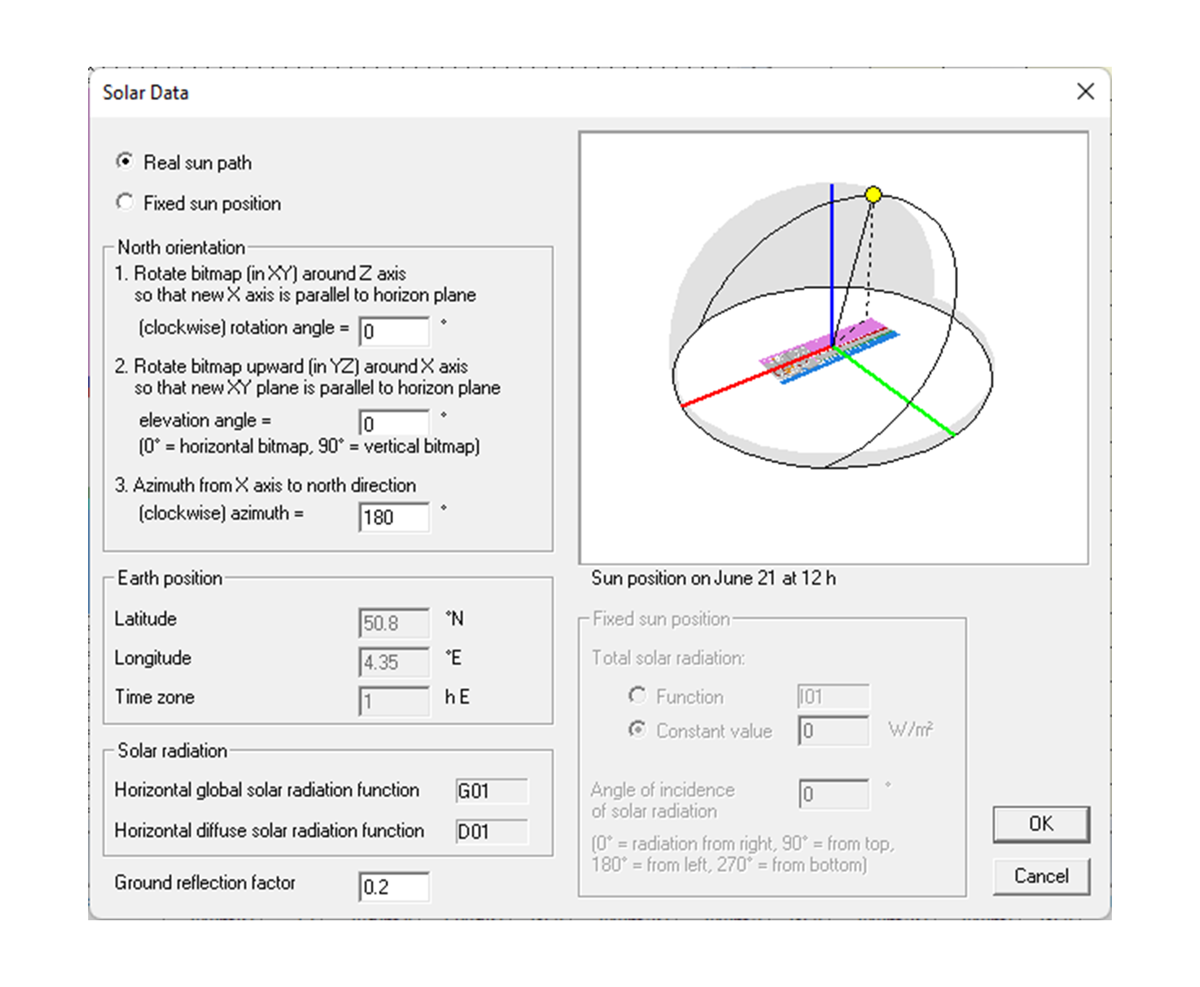
H5 - How to define the solar data for the solar processor in BISTRA?
This document explains how to set up the solar data for the solar processor in BISTRA.
BISTRA allows the simulation of solar radiation imposed on the geometrical model defined in the bitmap.
Two methods are available:
- Method 1: Real sun path
- Method 2: Fixed sun position
Keywords: Solar processor, Solar data, orientation
download pdf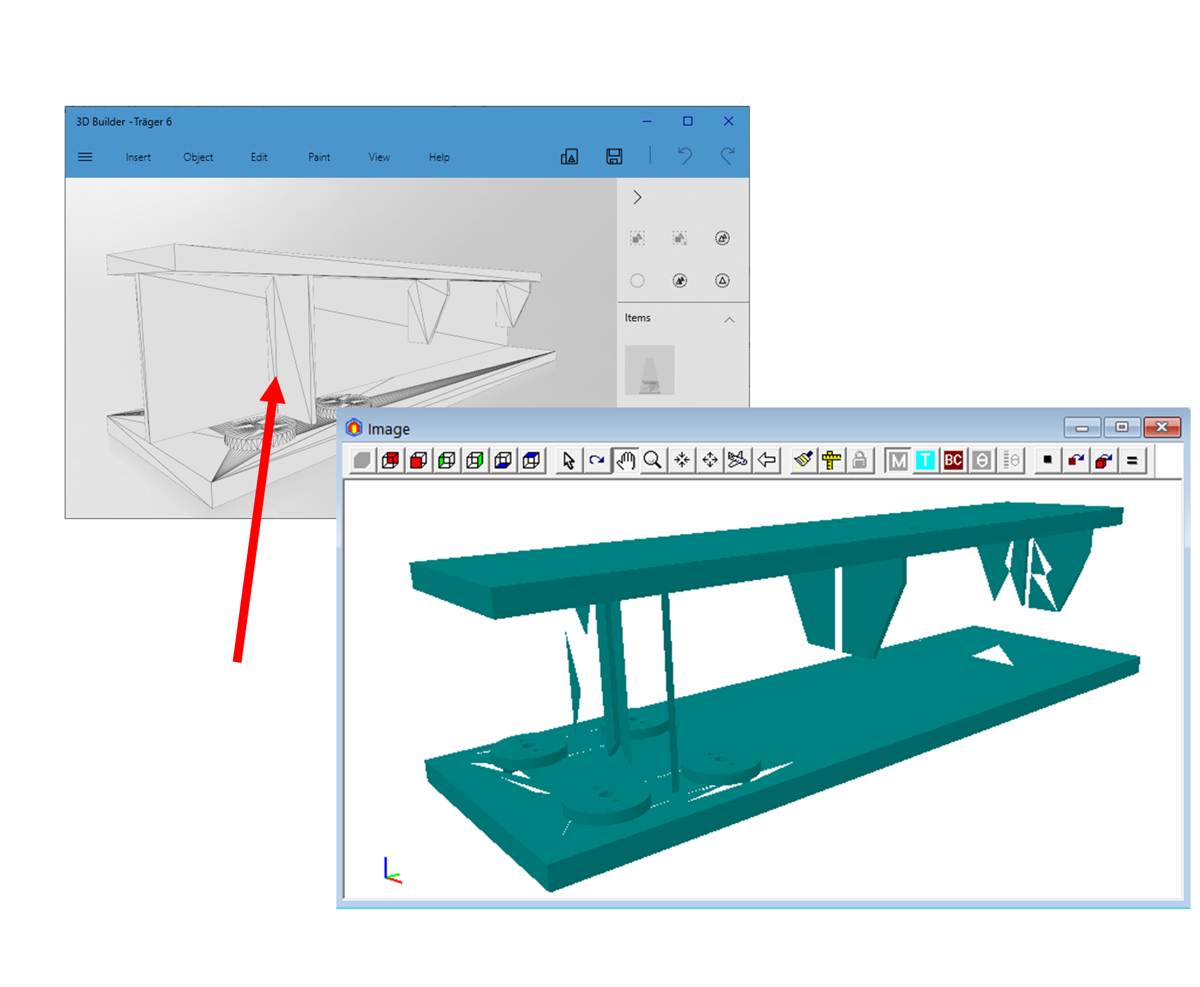
H7-How to merge an STL file for SOLIDO ?
For optimal use in SOLIDO the triangles defining the object in the STL-file should only be positioned on the objects surface. When the STL file contains internal surfaces, problems may occur when using the files as input in SOLIDO.
This document explains how to fix this.
Keywords: STL, SOLIDO, merge STL
download pdf download files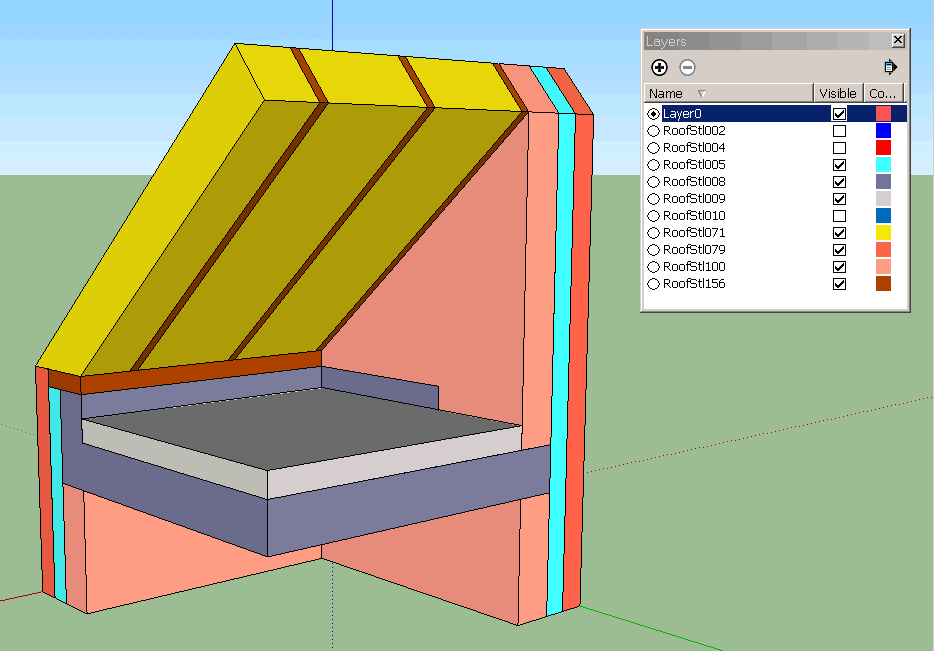
E1-Create STL with SketchUp or RHINO for SOLIDO/TRISCO
The steps are described to create STL files with Sketchup and use them for SOLIDO or TRISCO: from the drawing to the importation of a STL file in TRISCO.
Keywords: SOLIDO, TRISCO, STL files, Google SketchUp
download pdf download files
A9-Validation of the programs BISCO and TRISCO according to EN 1745
Annex D of the standard EN 1745:2012 “Masonry and masonry products – Methods for determining thermal properties” contains 3 test reference cases (1 2D and 2 3D). The validations simulations are done using the programs BISCO and TRISCO.
Keywords: BISCO, TRISCO, EN 1745, masonry
download pdf download files
D1 - Clear sky radiation visual validation
This document discusses the occurrence of hoarfrost due to clear sky radiation.
The first case study discusses formation of frost on the external glazing surface of a roof window. The second case studies the frost pattern on a car, only partly parked in a garage.
Both cases are simulated as a steady-state problem using the program TRISCO with RADCON.
Keywords: TRISCO, BISCO, radiation, frost, glazing, visual validation
download pdf download files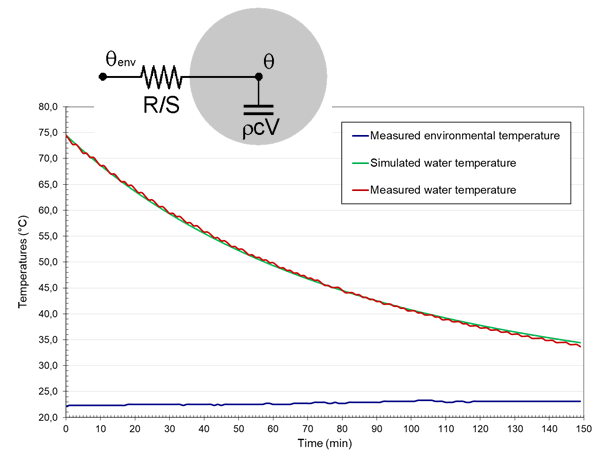
Experimental validation of transient heat transfer simulation
The temperature evolution of a small barrel of hot water positioned in a room with almost constant temperature was measured and compared to the numerical simulation of the cooling process. 2 simulations were made, one using an analytical formula and another one using the program VOLTRA.
Keywords: VOLTRA, experimental validation, cooling process, transient
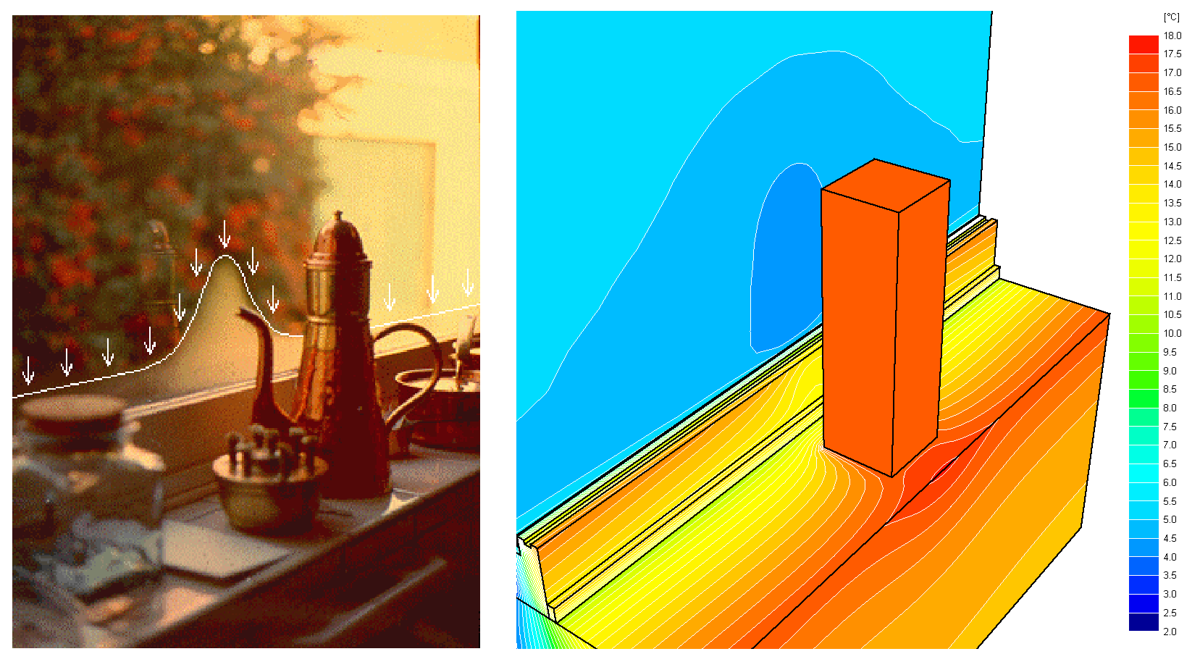
Low emissivity visual validation
On a single glazing, condensation occurs more intensively behind a copper coffee pot. This is due to the low emissivity of the coffee-pot. A simulation using the program TRISCO (with RADCON module) results in a similar isotherm course as the condensation pattern.
Keywords: TRISCO, radiation, condensation, visual validation

B3-The thermal transmittance of masonry according to EN 1745
Some examples are given showing how to calculate the thermal transmittance of masonry according to the standard EN 1745. The examples were prepared using the programs BISCO, TRISCO and SOLIDO.
Keywords: BISCO, TRISCO, SOLIDO, masonry, EN 1745
download pdf download files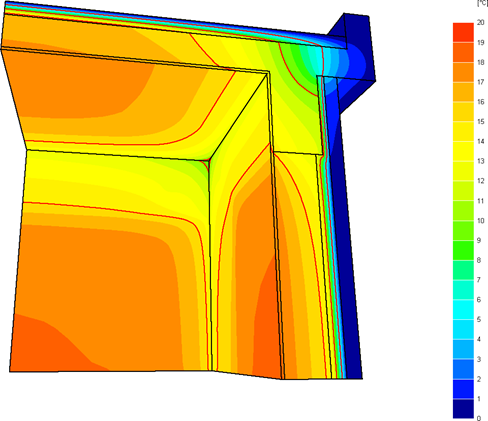
Thermal bridge surface condensation case study
On the internal surface of thermal bridges low temperatures occur in wintertime, causing a risk of surface condensation and mould growth. A 3D corner joining 2 façade walls and a flat roof is analysed as an example.
Keywords: TRISCO, thermal bridge, condensation, corner, mould growth
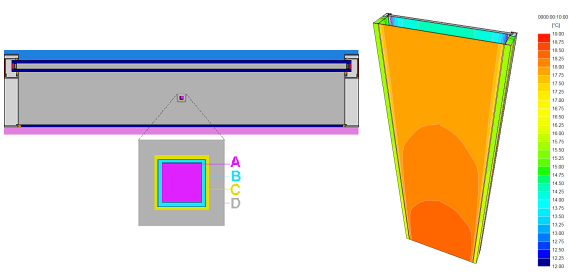
Simulating ventilated double façades using the program BISCO or TRISCO
BISCO and TRISCO (with RADCON module) can be used to simulate ventilated double façades in steady state. The ventilation heat flow is replaced by an equivalent convective heat flow to a small pipe. The results are validated using the program VOLTRA.
Keywords: BISCO, TRISCO, VOLTRA, ventilated double façade, equivalent convective heat flow
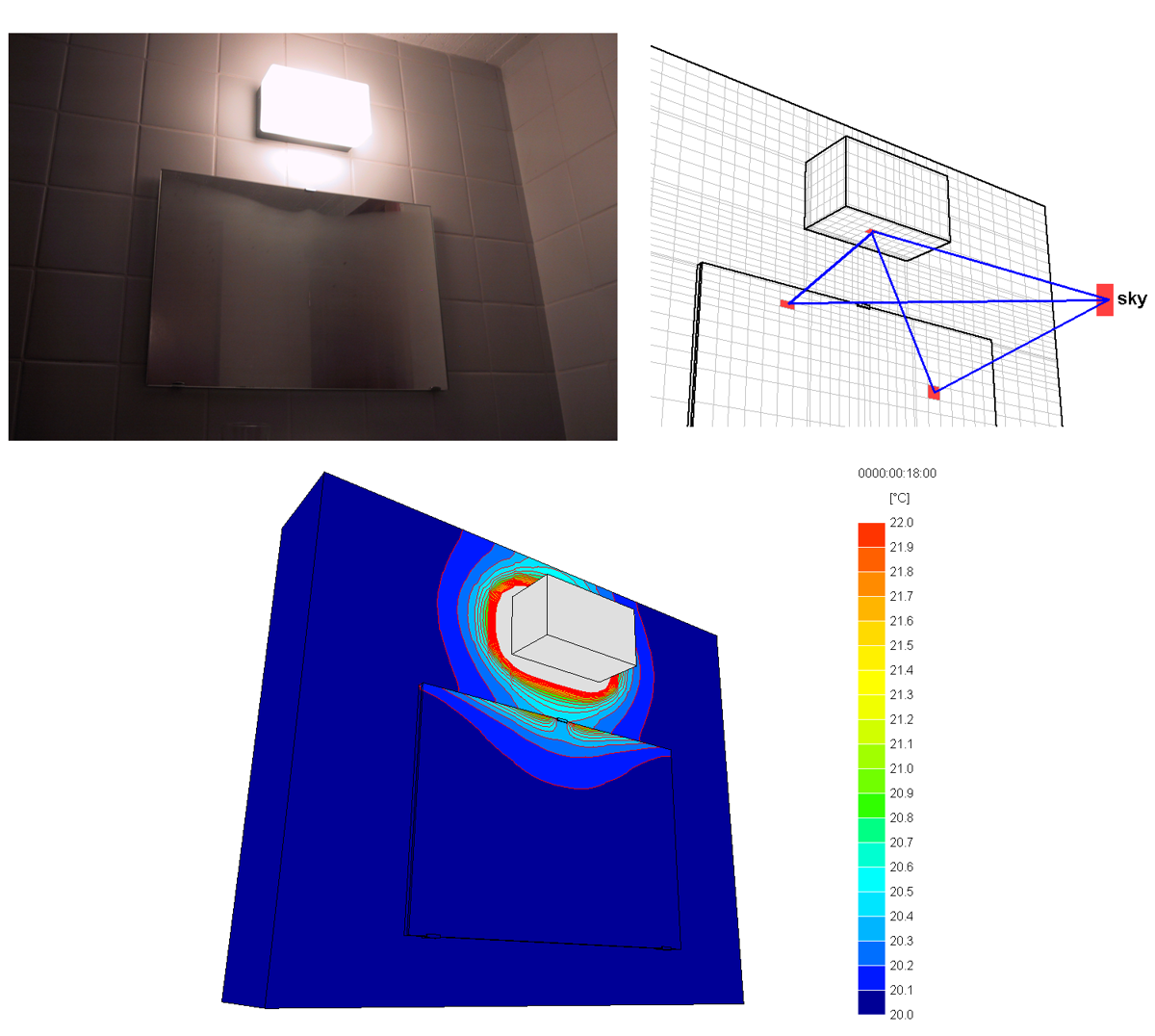
Visual validation of 3D heat transfer
At first sight a visual validation of heat transfer seems to be a contradiction: only the infrared radiation and not the visual light emitted by surfaces is related to the temperature. However, as surface condensation is visual and depends on the surface temperature, a visual validation of heat transfer is possible by comparing the pattern of drying surface condensation to the simulated isotherms on the surface.
Keywords: VOLTRA, visual validation, condensation, drying pattern, transient
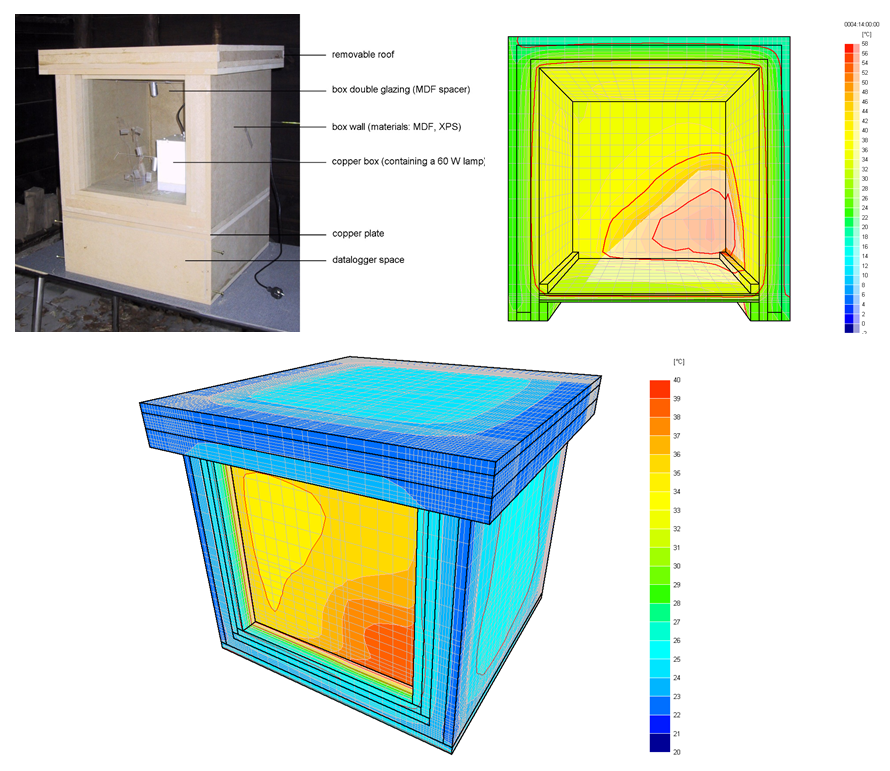
Experimental validation of the program VOLTRA for 3D transient heat transfer
Two experimental validations of the program VOLTRA for simulating 3D transient heat transfer were done on a small glazed wooden box. In the first indoors experiment the transient heat transfer due to a sudden internal power source was investigated. In the second experiment the box was put outdoors, allowing validating the solar processor module in VOLTRA.
Keywords: VOLTRA, experimental validation, glazed box, solar processor
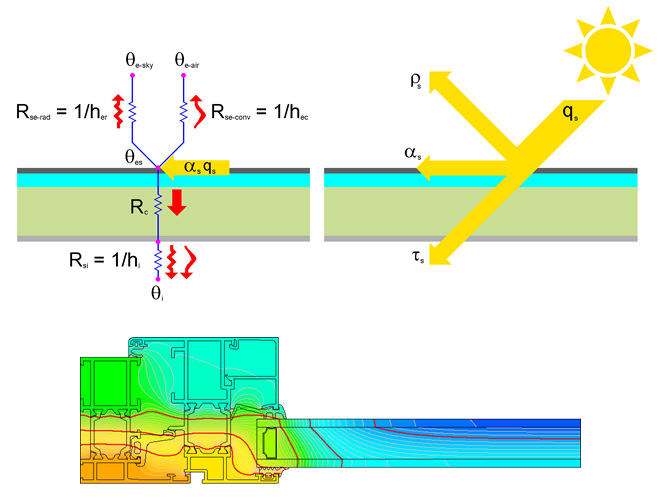
Thermal analysis of the building envelope in summer conditions – part I: opaque constructions
The knowledge of the maximum temperature that can occur in the building envelope is often of interest to investigate damage risk. Such thermal analysis can be done using multiple Physibel programs. Increasing levels of accuracy, corresponding to a decreasing degree of simplification, can be applied, as shown in multiple case studies.
Keywords: BISCO, CAPSOL, BISTRA, envelope, summer, opaque, EN 13791, EN 13792, ISO 6946, EN 10077-2
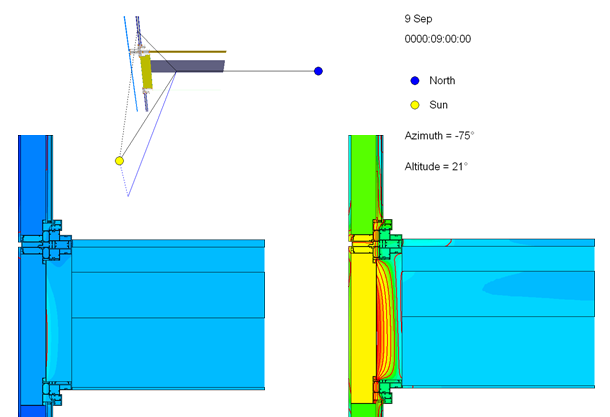
Thermal analysis of the building envelope in summer conditions – part II: transparent constructions
The knowledge of the maximum temperature that can occur in the building envelope is often of interest to investigate damage risk. A case study shows how the program BISTRA is used to simulate the temperature course in a glazed façade during a sunny day.
Keywords: BISTRA, summer, glazed façade, ISO 10456, EN 673
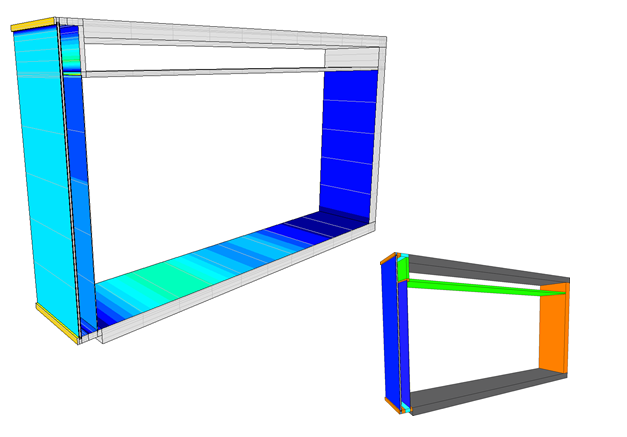
2D&3D transient simulations using the solar processor
Multiple simulation examples, with growing complexity, explain the use of the program VOLTRA for simulating the 2D & 3D transient behaviour of a room with a double façade.
Keywords: VOLTRA, solar radiation, double façade, ventilated cavity ISO 10456, EN 673

Air cavity – Stack effect simulation
An empirical method is used to calculate the stack effect in an air cavity or in a room connected to an environment at a different temperature through an inlet and an outlet at different levels. The method is implemented in an Excel spreadsheet. An example is given on how to use the method in the program CAPSOL.
Keywords: CAPSOL, stack effect, cavity, spreadsheet, airflow

C22 - The equivalent thermal conductivity of a perforated metal plate
The heat transfer through building components including perforated metal plates is 3D. If a 2D simulation is preferred or if the 3D component is relatively complex, it is helpful to replace the perforated plate by a homogeneous plate. A method for calculating the equivalent thermal conductivity of a perforated metal plate is explained and validated.
Keywords: BISCO, TRISCO, equivalent conductivity, 3D, 2D, ISO 10211
download pdf download files
C15-Phase-Change Materials (PCM)
A phase-change material (PCM) stores and releases heat when melting and freezing, which occurs at given temperatures. The programs VOLTRA and BISTRA allow simulating the thermal behaviour of objects in which such PCM’s are embedded. As an example, the temperature course in 2 identical rooms, one without and one with PCM is simulated.
Keywords: VOLTRA, BISTRA, PCM, dynamic, thermal comfort
download pdf download files
C16-Heat losses from a radiator to a glazed façade
The heat losses through an external wall behind a radiator are higher than the ones estimated by a standard wall heat loss calculation.
This is mainly due to infrared radiation.
An example shows how to investigate the supplementary radiation heat loss and how to evaluate improvements such as radiation shields.
Keywords: BISCO, RADCON, radiosity
download pdf download files
Dealing with thin metallic layers in the program BISCO
The heat transfer through thin metallic layers can be simulated using the Physibel programs TRISCO and BISCO. Whereas thin layers are possible in TRISCO (through thin grid widths), the lowest layer thickness in BISCO is limited to the pixel size. A very small pixel size sometimes results in a too large bitmap due to a memory problem. An alternative approach for such cases is proposed. The method is validated for a plastic glazing spacer covered with a metallic layer.
Keywords: BISCO, thin layers, metallic, glazing spacer

C10-Thermal simulation of vacuum glazing
Creating a vacuum layer between 2 glazing panes, of which one has a low emissivity coating, results theoretically in a glazing with a very low thermal transmittance, due to a very low heat transfer by conduction and radiation over the cavity. However, practically border and punctual spacers are required to maintain the vacuum. These spacers cause an additional 3D conduction heat transfer effect, increasing the thermal transmittance. The vacuum glazing is simulated in 3D using the program TRISCO with the RADCON module.
Keywords: TRISCO, vacuum glazing, spacers, RADCON, EN 673
download pdf download files
C4-BISCO - sample building components
This document describes example projects with BISCO related to building components. Following division is made:
- Thermal bridging
- Building physics, energy and thermal comfort
- Masonry
Keywords: BISCO, vertical joint, building sections, foundation, brick
download pdf download files
C3-BISCO – Sample window frames
A dozen of examples of BISCO simulation of window frames are given and detailed, including aluminium, wood, PVC and steel frames.
Keywords: BISCO, window frames, examples, shutter box, EN ISO 10077
download pdf download files
A1-Validation of the program BISCO according to EN ISO 10077-2:2017/A1:2025
Validation of the program BISCO according to Annex G, I and H in EN ISO 10077-2:2017
Keywords: BISCO, validation, EN ISO 10077-2, equivalent thermal conductivity, radiosity, RADCON
download pdf download files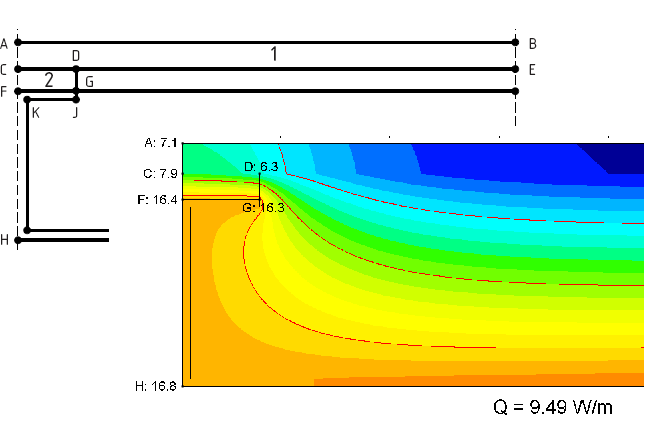
A2-Validation of the program BISCO according to ISO 10211
Annex C of the standard ISO 10211 contains 2 two-dimensional test reference cases. In order to be classified as a two-dimensional steady-state high precision method, BISCO shall give results corresponding with those of these 2 cases.
Keywords: BISCO, standard examples, validation, ISO 10211
download pdf download files
C7-Clear sky radiation - undercooling condensation
Due to clear sky radiation the external building envelope surface temperature can be lower than the outdoors air temperature. A roof edge, in which a condensation problem occurred in early spring, is simulated both under steady state and transient conditions. The case studies show that the clear sky radiation causes the condensation problem.
Keywords: BISCO, clear sky, radiation, glazing, ventilated cavity, RADCON
download pdf download files
C12-Thermal analysis of a floor heating system
For a floor heating system, the water temperature course and the floor temperature distribution are simulated using the transient programs BISTRA and VOLTRA, both in steady and transient state.
Keywords: BISTRA, VOLTRA, floor heating, cooling, inertia
download pdf download files
C8-Thermal simulation of reflective foils
When the material surfaces around a cavity have a low infrared emissivity, for example if they are covered by an aluminium foil, the radiation heat transfer is reduced. Using an example, it is shown how to deal with such reduced cavity heat transfer in the Physibel software.
Keywords: BISCO, TRISCO, reflective foils, radiation, RADCON, ISO 6946, low-e
download pdf download files
Transient solar heat gains through a glazing with a solar shading
A method for calculating the effect of solar shading systems on the solar transmittance of a glazing is explained. The solar factor as defined in EN 410 is of little use for this purpose because it is defined for a solar radiation with a direct component that is perpendicular to the glazing. The programs BISTRA (2D) and VOLTRA (3D) contain a solar processor that takes the sun position into account and allow simulating a kind of transient solar factor.
Keywords: BISTRA, VOLTRA, glazing, shading, solar radiation

C20-View factor calculation using the program TRISCO
View factors are used in the simulation of advanced infrared radiation heat transfer. In the Physibel 2D & 3D software the view factors are automatically calculated and implemented in the radiation equations (RADCON feature).
The explicit knowledge of the view factors is usually of little importance, but sometimes view factors values are needed for use in other applications. An example is given how view factor values can be derived from the program TRISCO.
Keywords: TRISCO, RADCON, radiosity
download pdf download files
C13-Efficiency of frost insulation to protect a foundation
A case study shows how the program BISTRA can be used to evaluate the efficiency of frost insulation protecting a foundation.
Keywords: BISTRA, VOLTRA, foundation, frost insulation
download pdf download files
C14-Thermal Transmittance calculation of a veranda
A case study shows how the thermal transmittance of a veranda can be calculated taking into effect the 2D thermal heat loss effects through frames and glazing edges. A methodology compliant to the standards EN ISO 6946 and EN ISO 10077-2 for use with the Physibel program BISCO is explained and applied.
Keywords: BISCO, greenhouse, veranda, porch
download pdf download files
B2-3D & 2D Simulation of fixings – validation of EN 12631:2017 ANNEX E
Annex E of the standard ISO 12631:2017 contains a smoothed λ method to include the thermal effect of fixings in 2D numerical calculations. It is implemented in BISCO and the results are compared to a realistic 3D simulation in SOLIDO and to other alternative methods in BISCO and TRISCO.
Keywords: BISCO, TRISCO, SOLIDO, screws, 2D numerical method, EN 12631–Annex E
download pdf download files
B9-Calculation of the linear thermal transmittance of a glazing spacer using the program BISCO
The calculation of the linear thermal transmittance of a glazing spacer according to EN ISO 10077-2 requires two BISCO simulations. A first one, with an insulation panel instead of the glazing, results in the thermal transmittance of the frame. From this value and from a second simulation, with a specific glazing, the linear thermal transmittance of the glazing spacer can be derived.
Keywords: BISCO, spacer, EN ISO 10077-2
download pdf download files
C5-Simulation of internal surface corner heat transfer using the RADCON module
According to standard 10077-2, reduced heat transfer coefficients should be applied at internal corners. As an alternative, the use of the type BC_SKY (RADCON module) in BISCO allows a rather correct physical simulation of the surface heat transfer by radiation and convection. In this document both methods are implemented and compared for 4 cases.
Keywords: BISCO, internal corner, heat transfer coefficient, EN 10077-2, EN 6946, RADCON
download pdf download files
C6-Thermal simulation of non-ventilated cavities using the RADCON module
This document discusses the methods described in various standards for the non-ventilated cavities thermal simulations and their implementation in the Physibel software. This includes the λeq and the radiosity methods of EN 10077-2, with both linear and non-linear radiation models.
Keywords: BISCO, TRISCO, non-ventilated cavities, EN 10077-2, EN 6946, EN 673
download pdf download files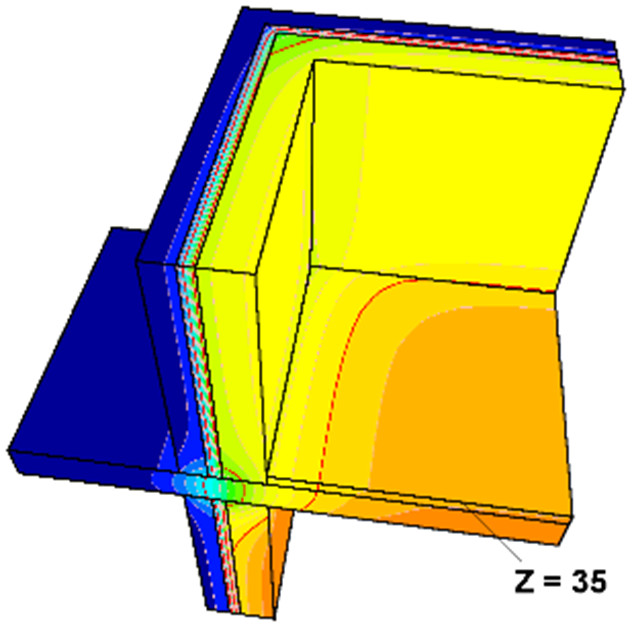
Program TRISCO – Node temperature postprocessor
A postprocessor spreadsheet tool is discussed in this document. It allows reporting the node temperatures at selected grid positions.
Keywords: TRISCO, node temperature, spreadsheet tool

A3-Validation of the programs TRISCO & SOLIDO according to ISO 10211
Annex C of the standard ISO 10211 contains 4 test reference cases (2 2D and 2 3D) that must be used in order to be classified as a three-dimensional steady-state high precision method. The programs TRISCO and SOLIDO are used to simulate the 4 test examples.
Keywords: TRISCO, SOLIDO, validation, standards, EN ISO 10211
download pdf download files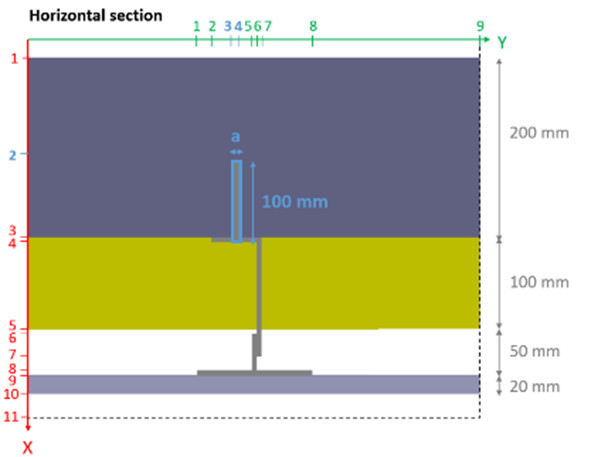
TRISCO Exercises
This document includes 5 exercises of TRISCO simulations: Cladding fixed with brackets; Brick wall; Brace; Exercise Pilotex from the manual and Junction roof-wall.
Keywords: TRISCO, 3D heat transfer, brackets, brick wall, brace, junction roof-wall

G1-Validation of simplifying the thermal simulation of an object with a 3D sloped metal bar
Objects containing sloped metal bars can be simulated thermally using the Physibel program SOLIDO. Because of the sloped shape a dense grid is required for a precise thermal simulation. Therefore, when simulating complex details containing sloped metal bars, it is often of interest to make a rectangular simplification. A few simplification methods are validated.
Keywords: TRISCO, SOLIDO, sloped shape, rectangular simplification
download pdf download files
B6-Floor thermal transmittance and foundation linear transmittance (EN ISO 13370 and EN ISO 10211)
To calculate the thermal transmittance of a floor on ground Ug, EN 13370 allows several methods: a 3D numerical method, a 2D numerical method and a simplified method. To calculate the linear thermal transmittance of a wall/floor junction ψg only the 2D and the 3D numerical methods are applicable. A case study shows the use of these methods.
Keywords: BISCO, TRISCO, floor, foundation, EN 13370
download pdf download files
B7-Linear transmittance of an internal wall foundation
The heat flow through a thermal bridge caused by an internal wall foundation depends on the size of the building and on the location of the internal wall. Therefore it is relatively complex to derive the linear thermal transmittance of such foundation details. A 3D thermal simulation of the whole floor is required. A simplified method is proposed in this document and validated, using a case study.
Keywords: TRISCO, internal wall, foundation, thermal bridge, ground
download pdf download files
B14-Linear thermal transmittance of a wall-floor junction
The linear thermal transmittance of a wall to basement floor junction is calculated according to EN ISO 10211 using the program TRISCO. In an extra step, floor heating is added.
Keywords: TRISCO, BISCO, wall floor junction, linear thermal transmittance, thermal bridge
download pdf download files
B1-Linear and point thermal transmittance of thermal bridges
The linear thermal transmittance and the point thermal transmittance for an external wall containing both a linear thermal bridge and a point thermal bridge are calculated using the program TRISCO.
Keywords: TRISCO, linear thermal transmittance, point thermal transmittance, thermal bridge
download pdf download files
B13-The linear transmittance of a ground floor – window sill construction detail
A procedure to calculate the linear thermal transmittance of a ground floor – window sill construction detail according to EN ISO 13370 is explained using a case study.
Keywords: BISCO, TRISCO, ground floor, window sill, linear thermal transmittance, EN 13370, EN 10211
download pdf download files
B5-Repeating thermal bridging according to EN ISO 10211
A massive brickwork wall is internally insulated. The thermal insulation is interrupted by a wooden stud at regular distances, causing a thermal bridge effect. This thermal bridge effect is quantified using the programs BISCO and TRISCO.
Keywords: BISCO, TRISCO, thermal bridge, repetition, thermal transmittance
download pdf download files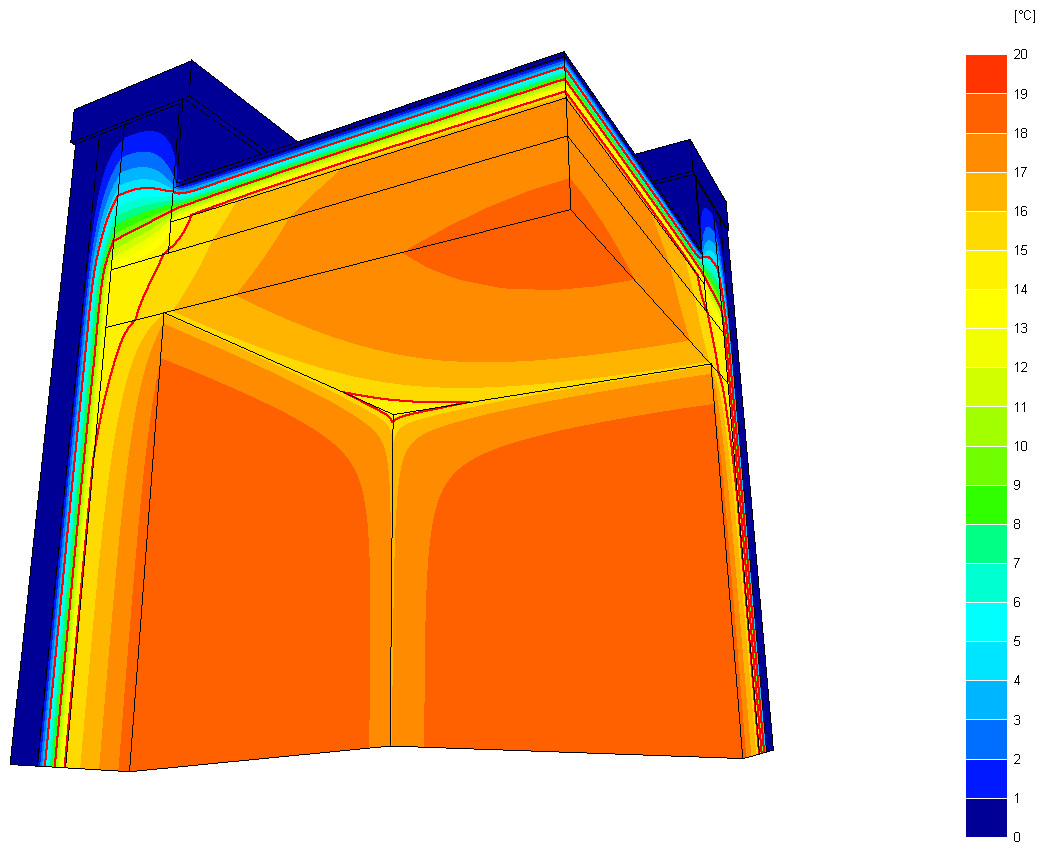
2D-3D Thermal evaluation of a roof junction
For a roof junction construction detail the linear thermal transmittance and the point thermal transmittance are derived, for both the internal and the external dimension system, using the programs BISCO and TRISCO. Also the 3D temperature course is derived allowing a surface condensation risk evaluation.
Keywords: BISCO, TRISCO, thermal bridge, roof junction

B15-Linear thermal transmittance of a wooden frame corner
The calculation of the linear thermal transmittance of a wooden frame corner is discussed. This thermal bridge effect is quantified using the programs BISCO and TRISCO.
Keywords: BISCO, TRISCO, linear thermal transmittance, wooden frame, corner
download pdf download files
B4-Thermal analysis of a wall to window junction according to EN ISO 13789
The thermal transmittance of a wall-window junction is calculated according to the applicable European standards. 2 approaches to analyse the problem are discussed: a 2D heat transmission calculation and a heat transmission calculation ‘by hand’.
Keywords: BISCO, TRISCO, wall window junction, EN 6946, EN 10077-2, EN 10211
download pdf download files
B17-Thermal bridge heat loss analysis in case of 3 environments
The heat loss through a thermal bridge between 2 environments (typically indoors and outdoors) can be described using a single linear thermal transmittance.
For a thermal bridge between 3 environments at different temperatures (e.g. indoors, outdoors and attic), 3 ψ-values are required. The procedure from Annex E of EN ISO 10211 , is applied for a sample thermal bridge.
Keywords: BISCO, TRISCO, linear thermal transmittance, 3 environments, EN ISO 10211
download pdf download files
B19-Introduction to the GLASER method
The Glaser method is explained with an Excel sheet using a basic case of a brick wall with interior insulation.
More detailed information can be found in:
- EN ISO 13788
- The Physibel program GLASTA manual.
Keywords: GLASTA, Glaser method, interstitial condensation
download pdf download files
B18- Deriving the minimal temperature factor to avoid surface condensation according to EN ISO 13788
The practical implementation of surface condensation and surface mould growth in the standard EN ISO 13788:2012 is discussed and illustrated with examples.
Keywords: BISCO, TRISCO, SOLIDO, surface condensation, surface mould growth, EN ISO 13788
download pdf download files





